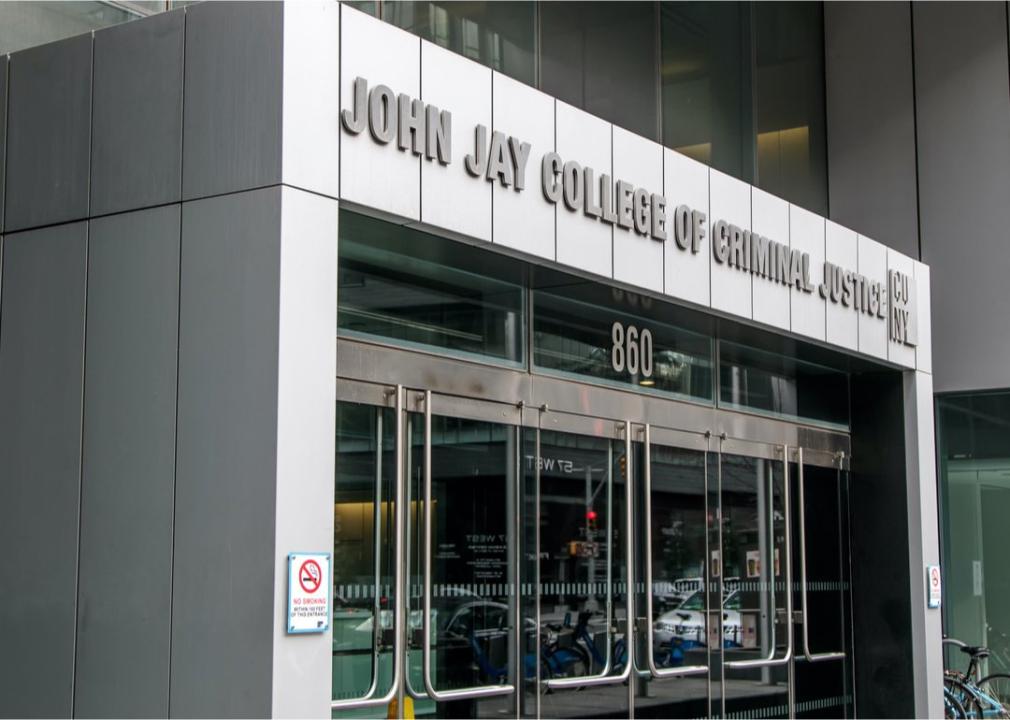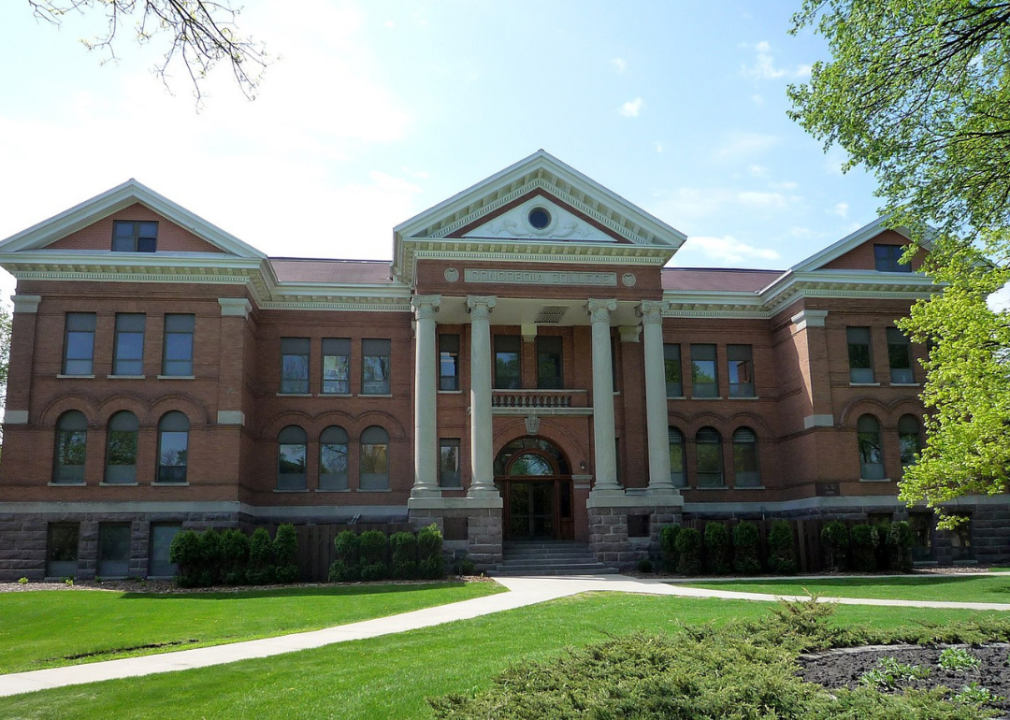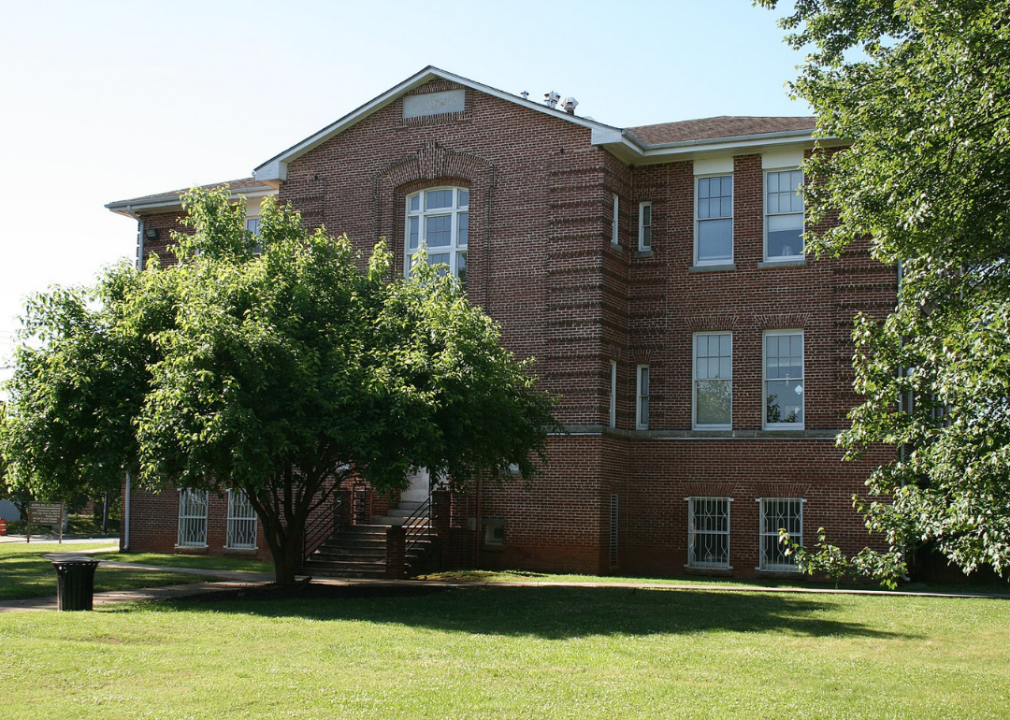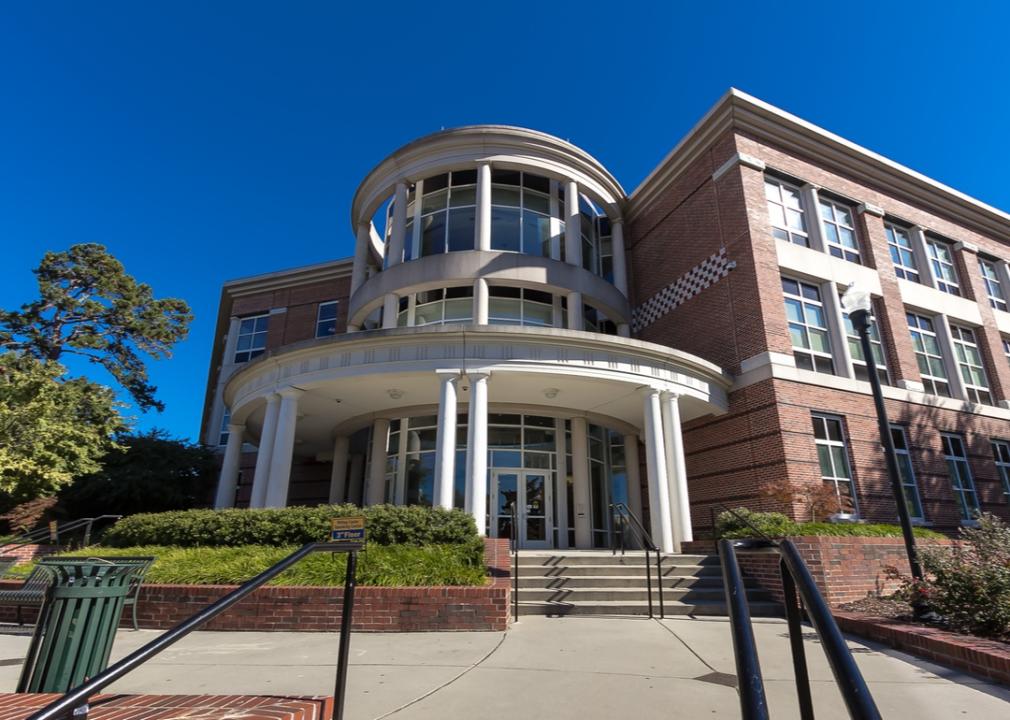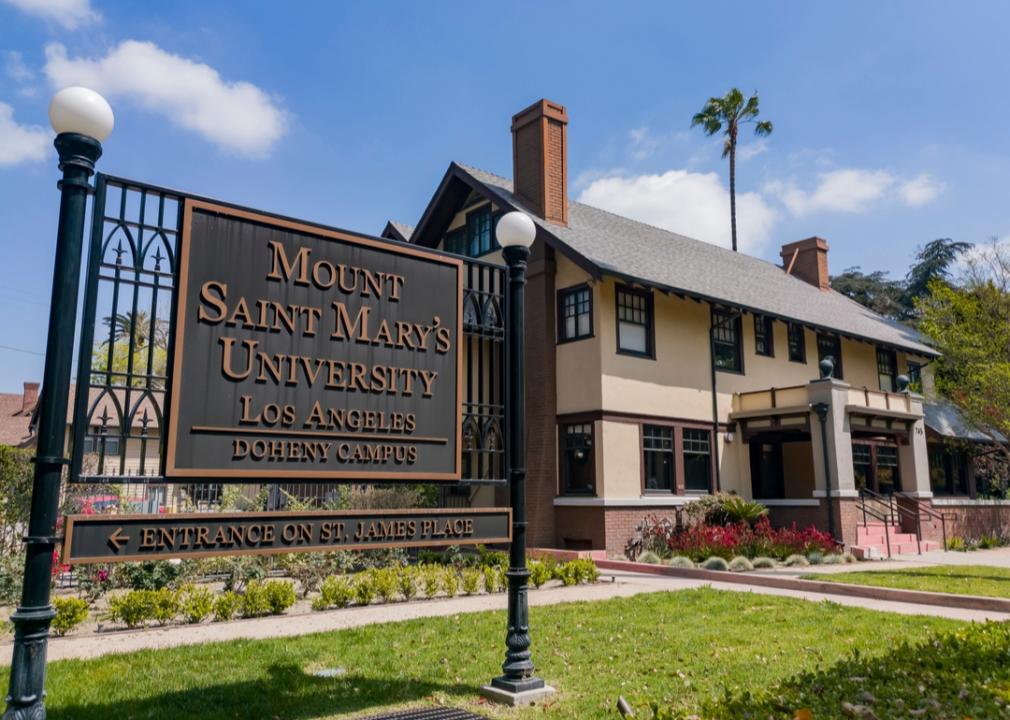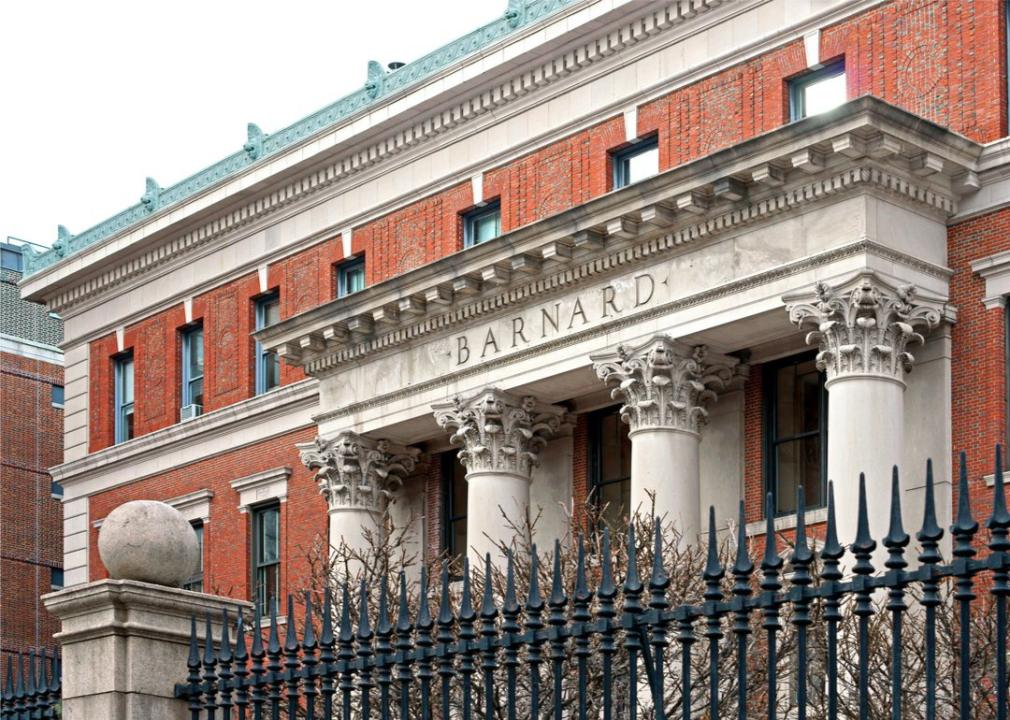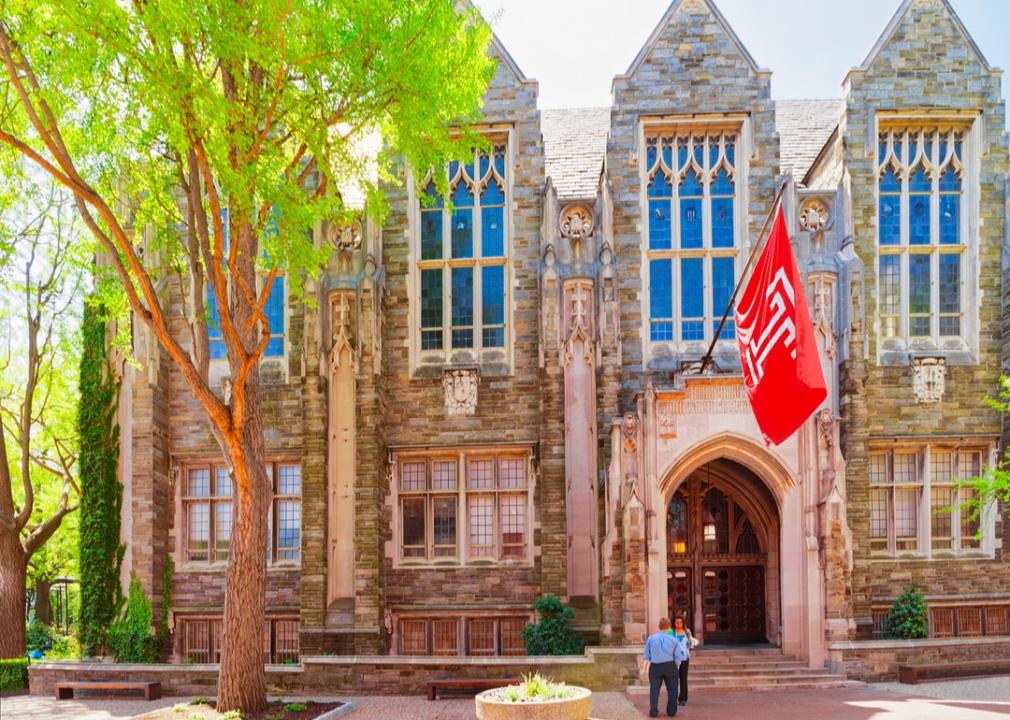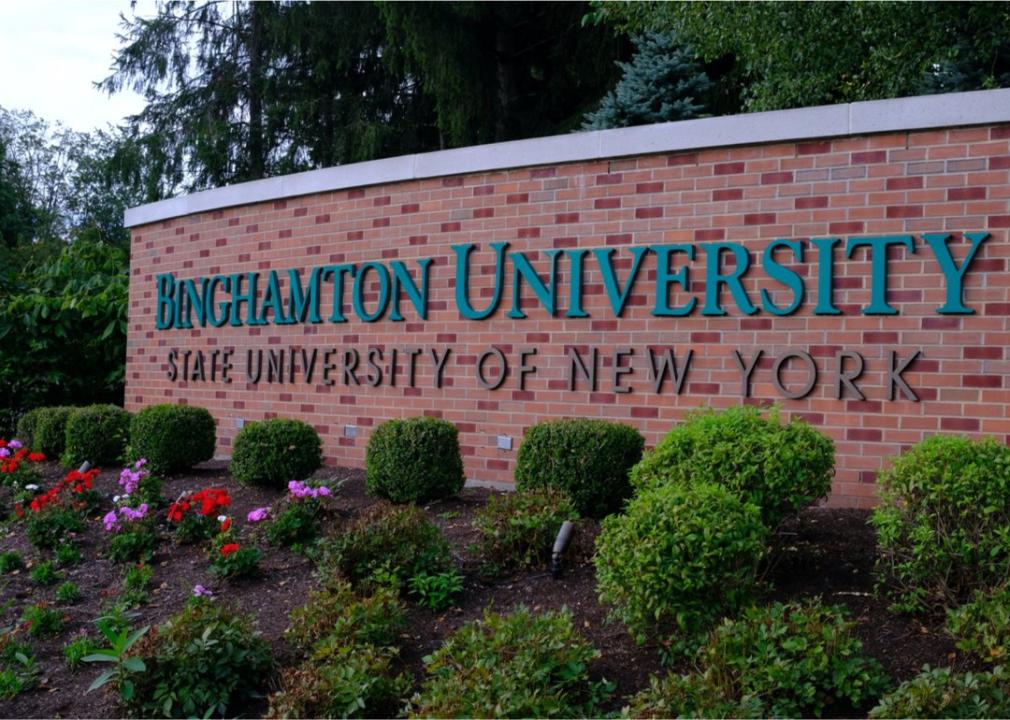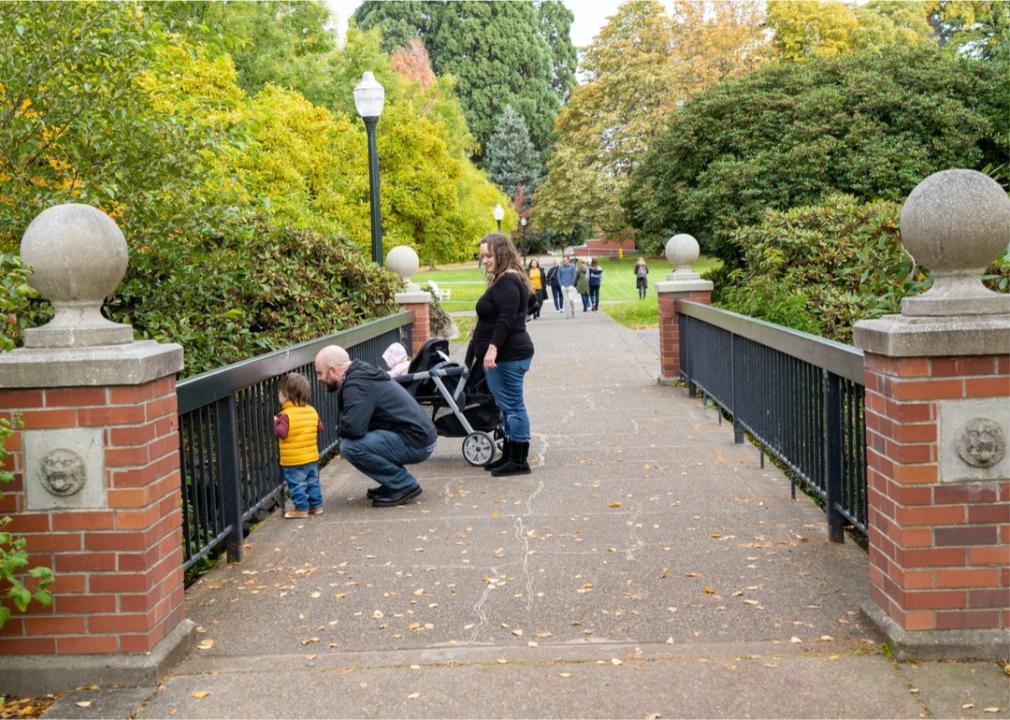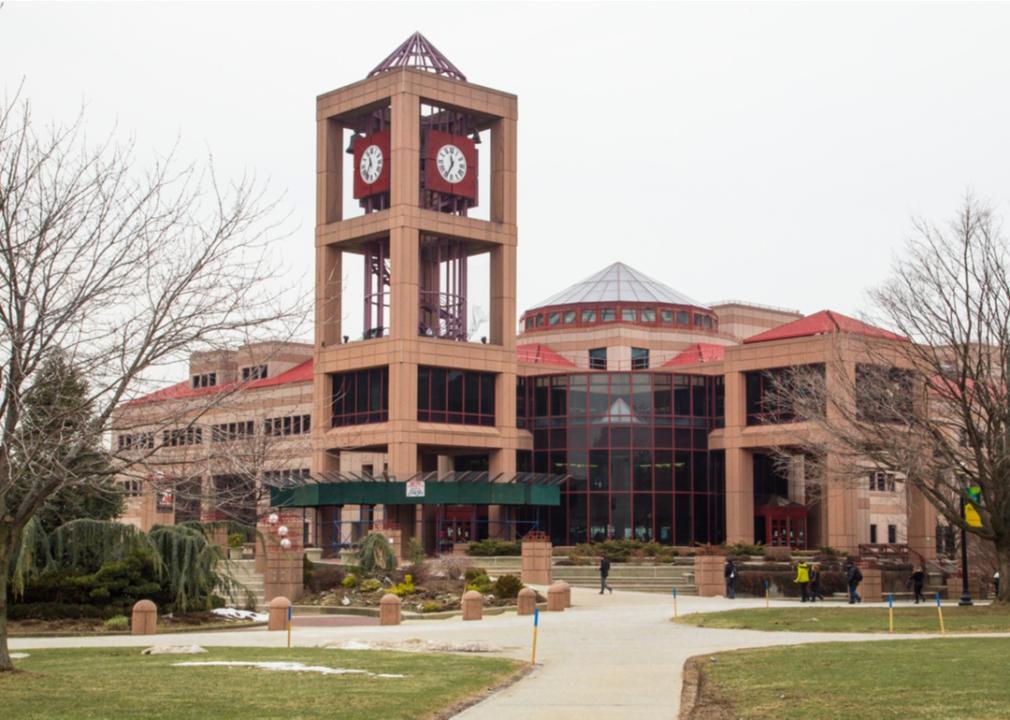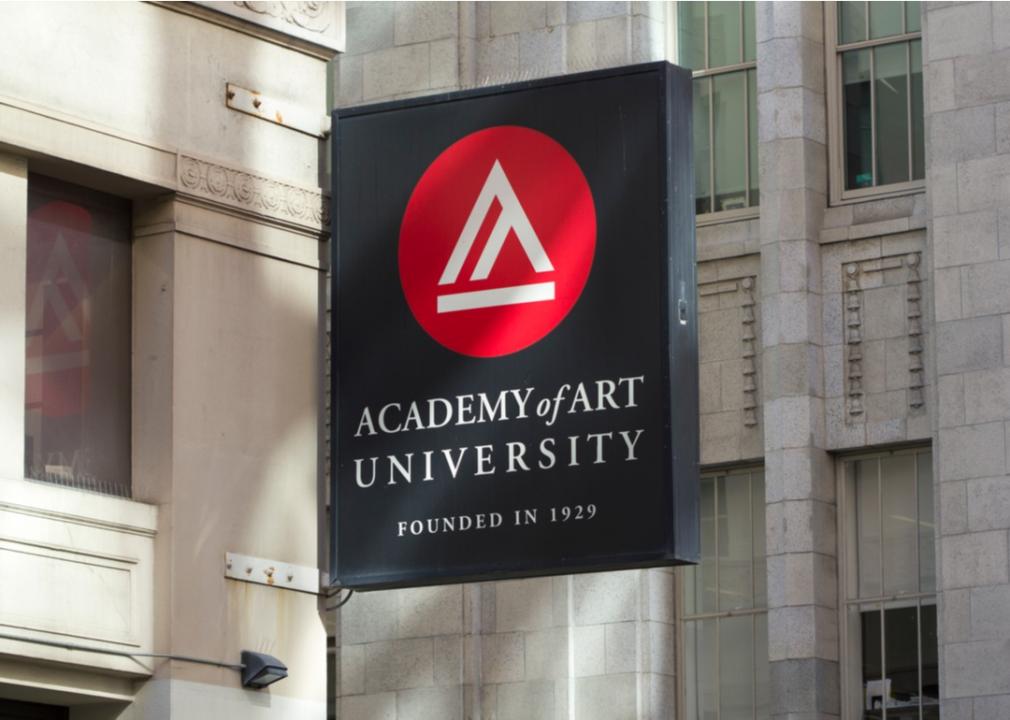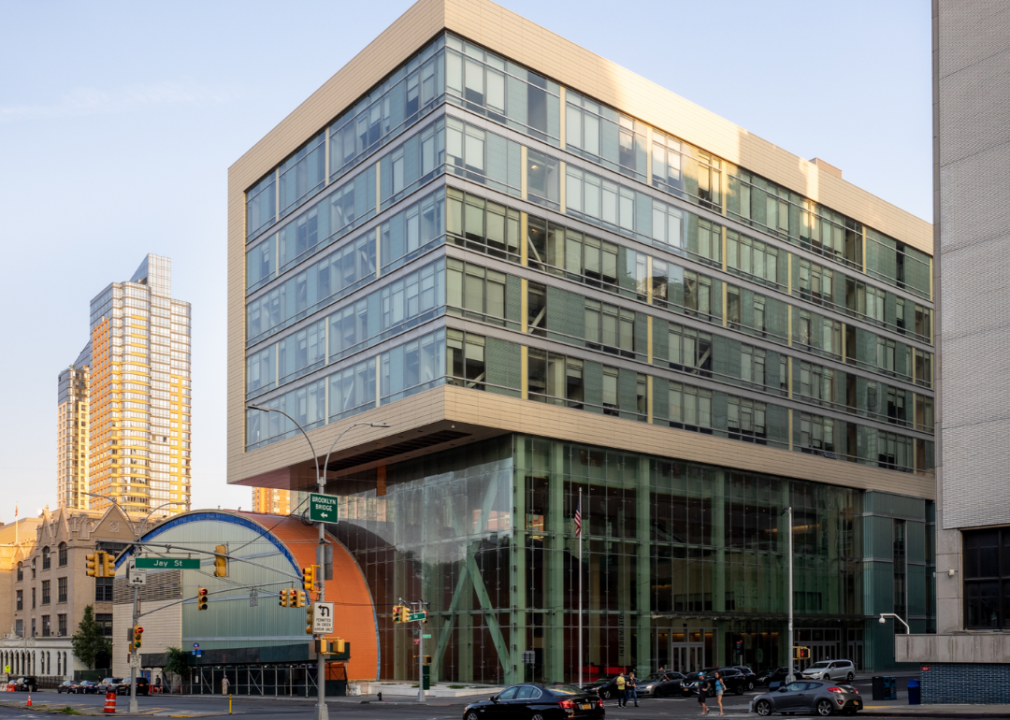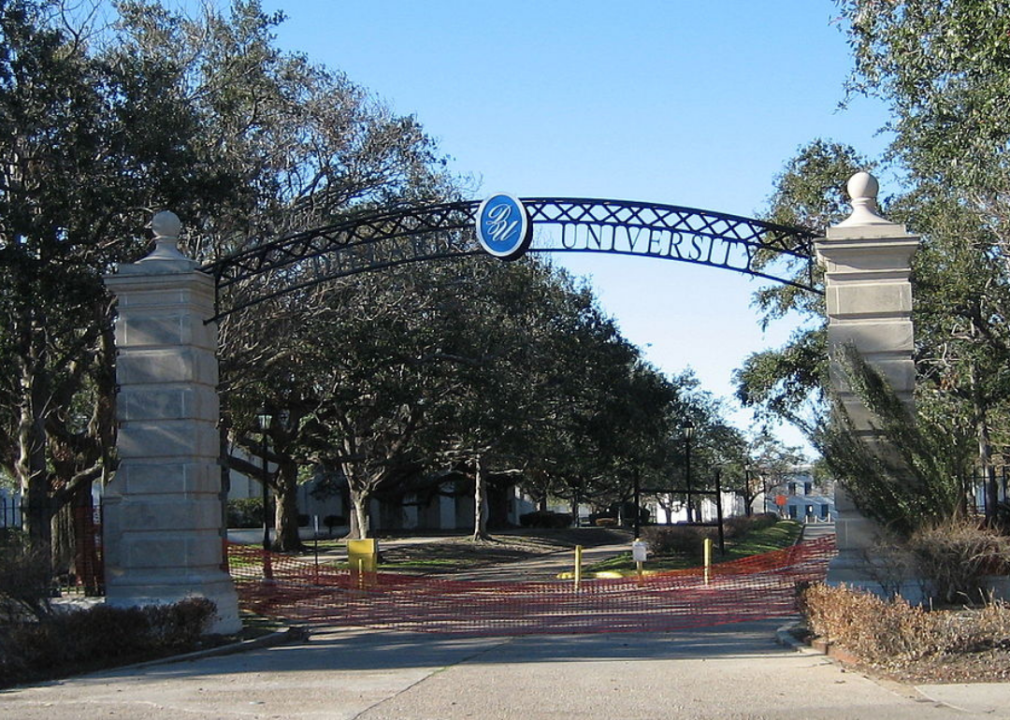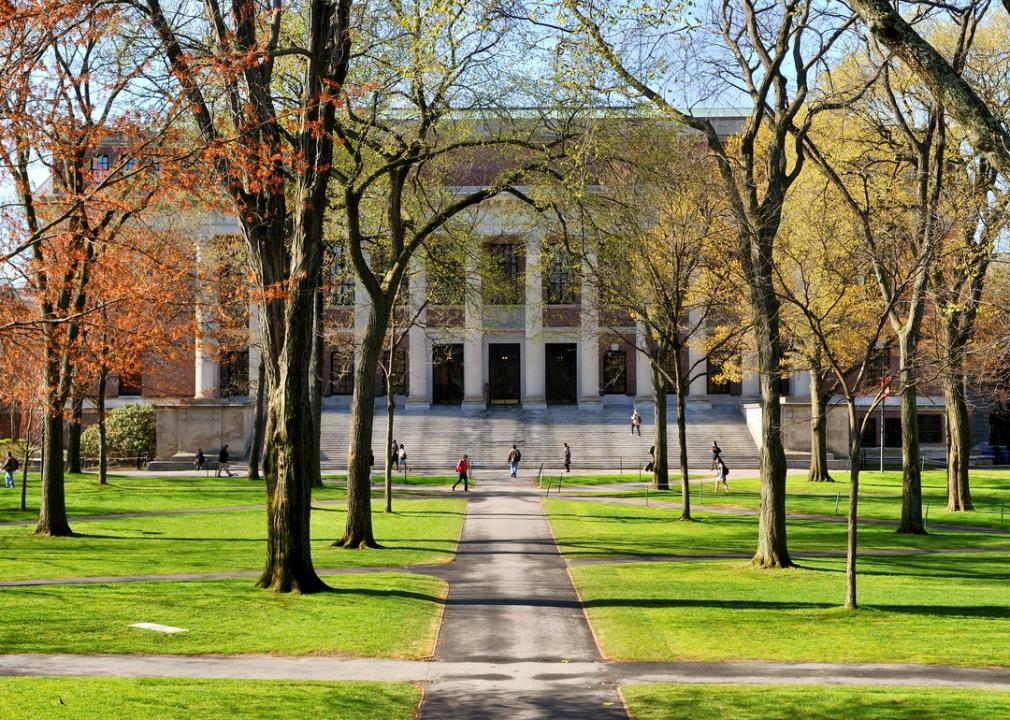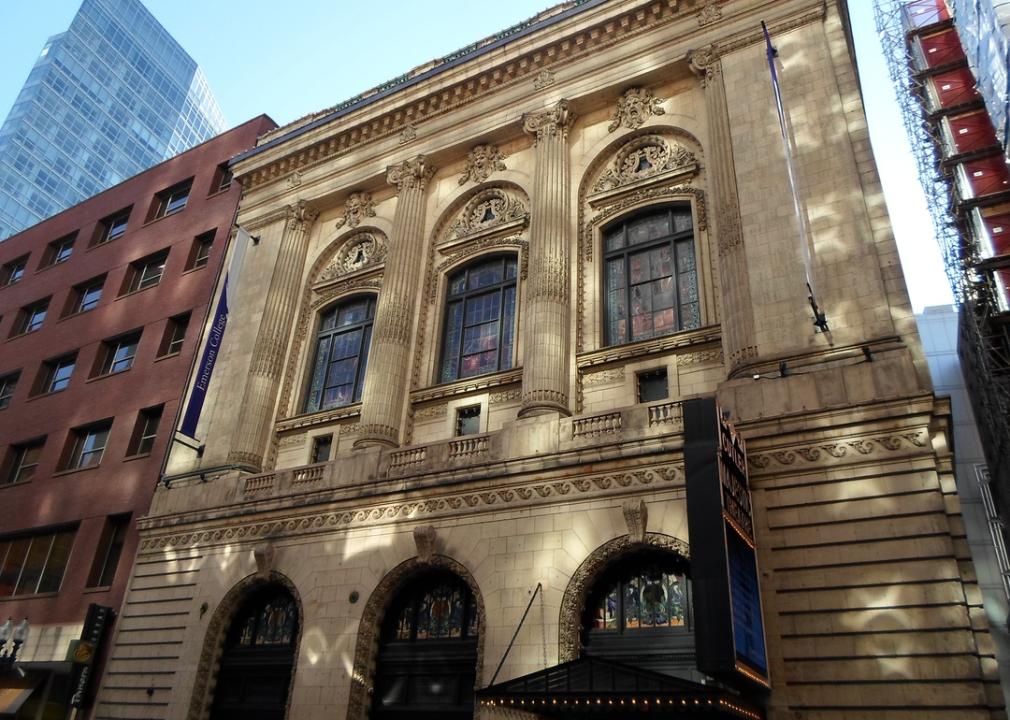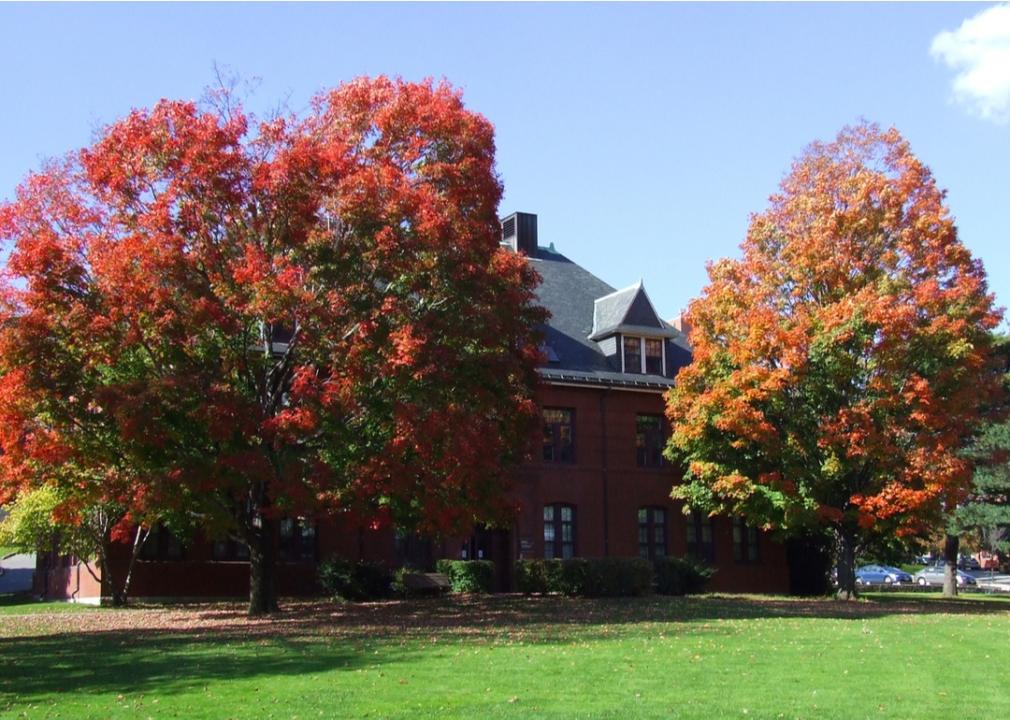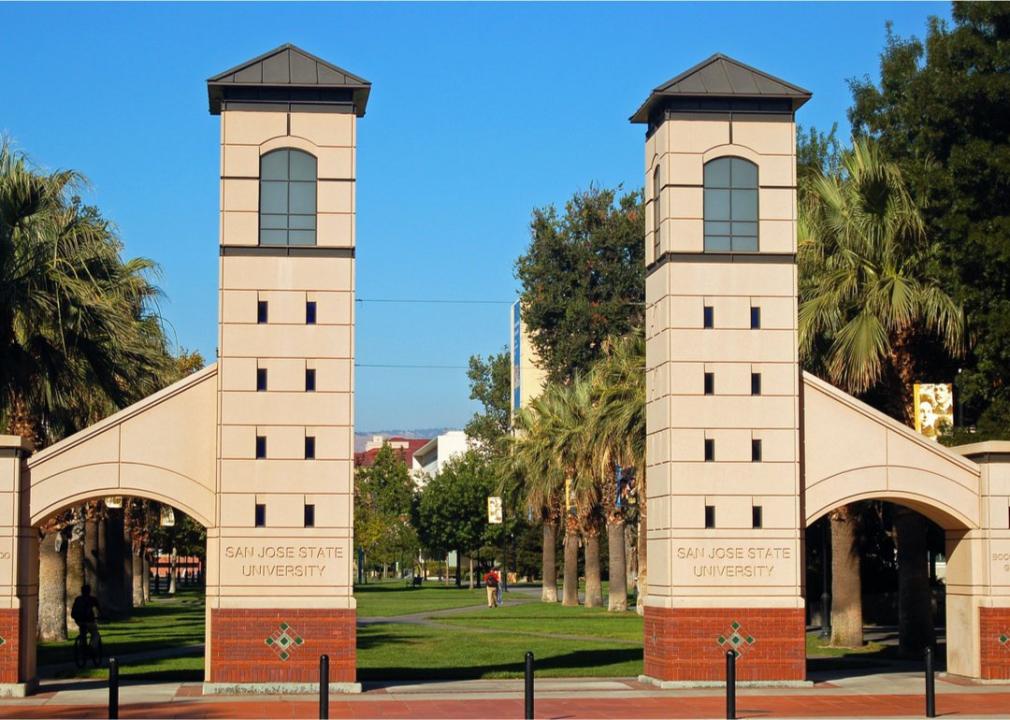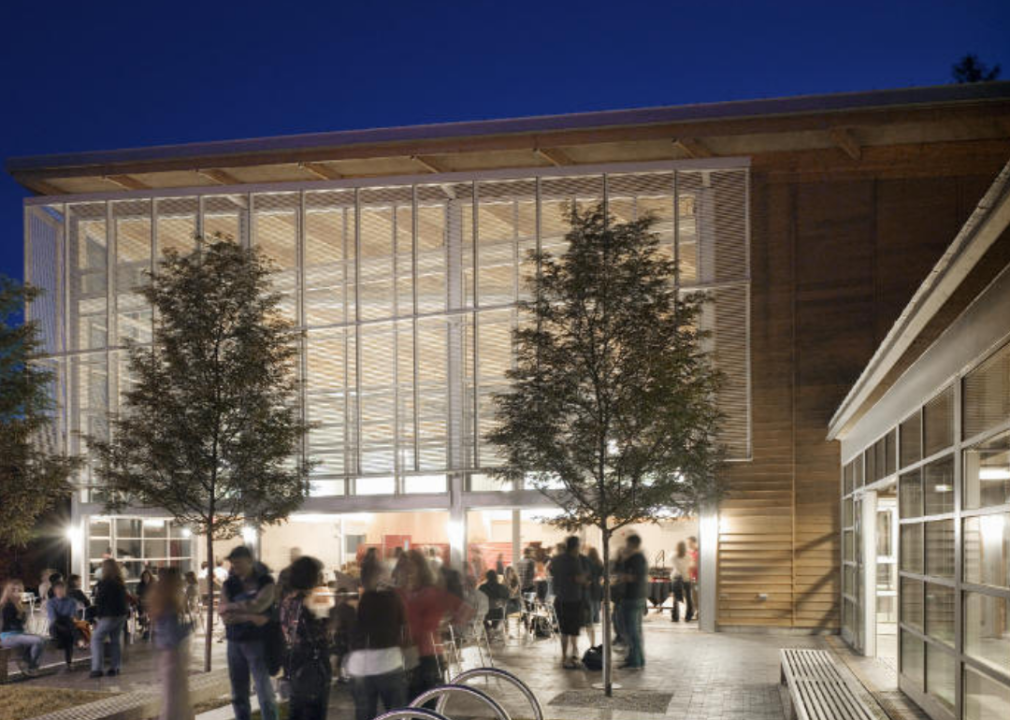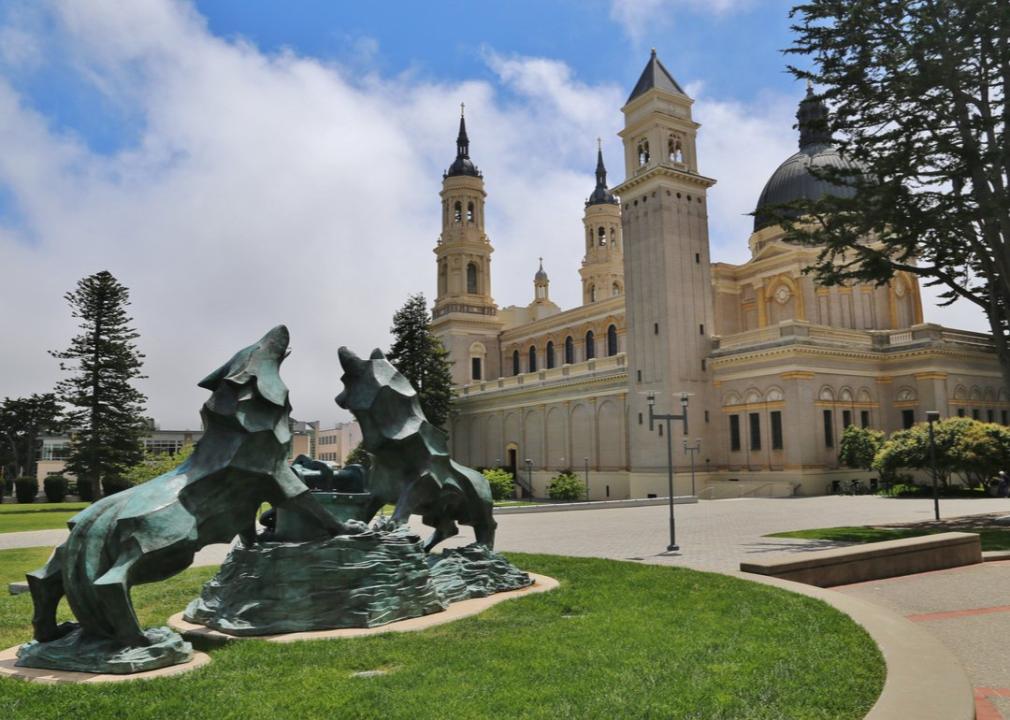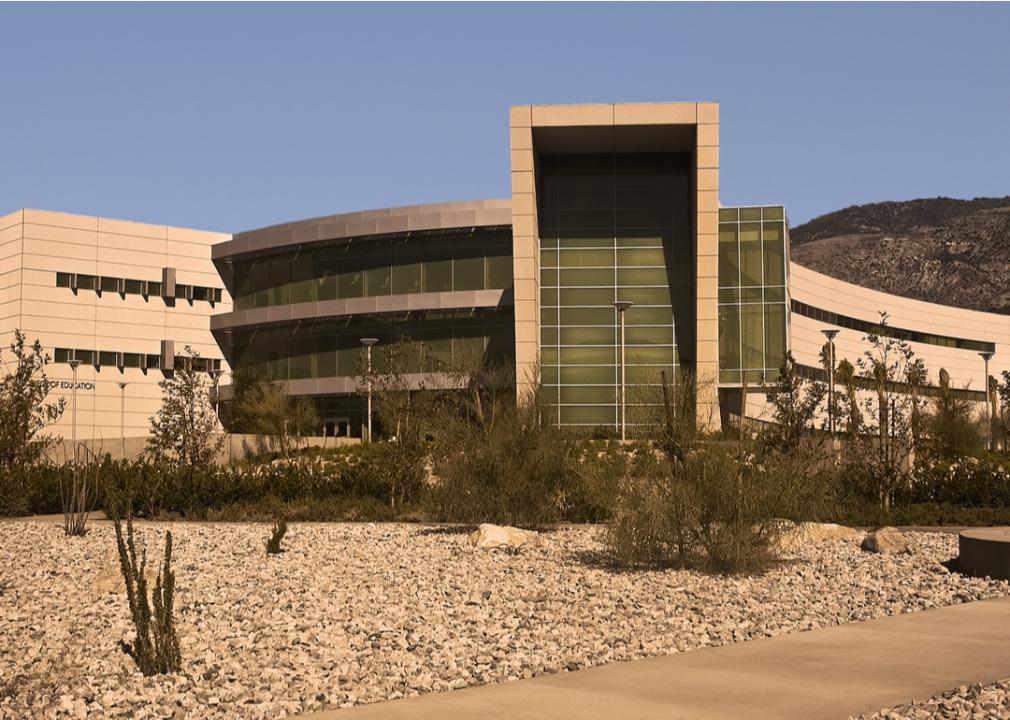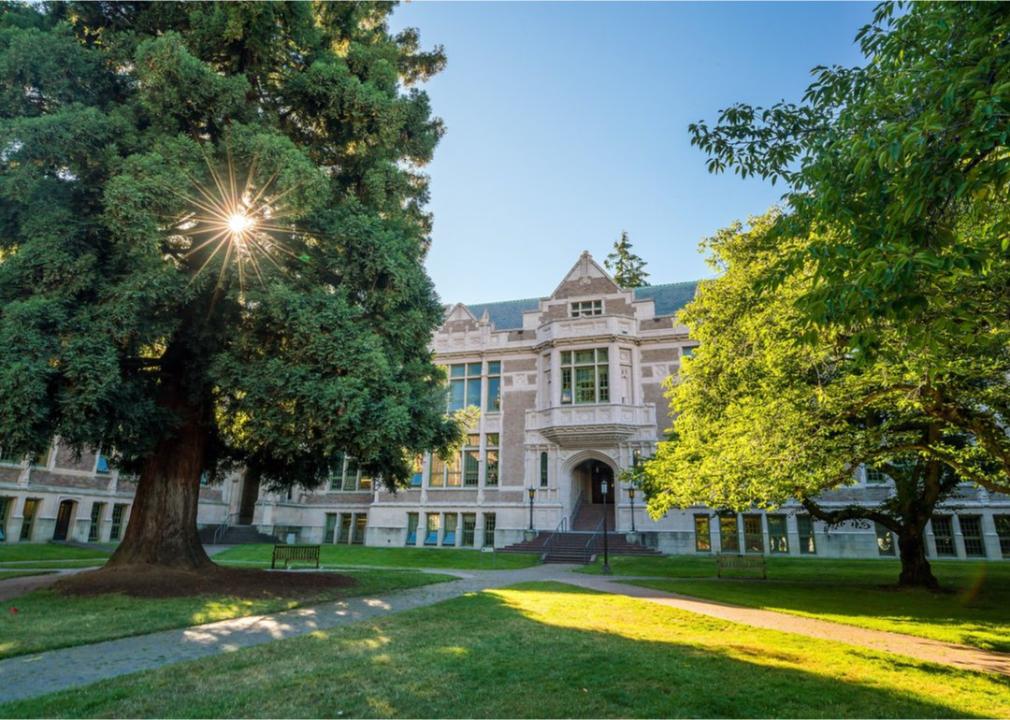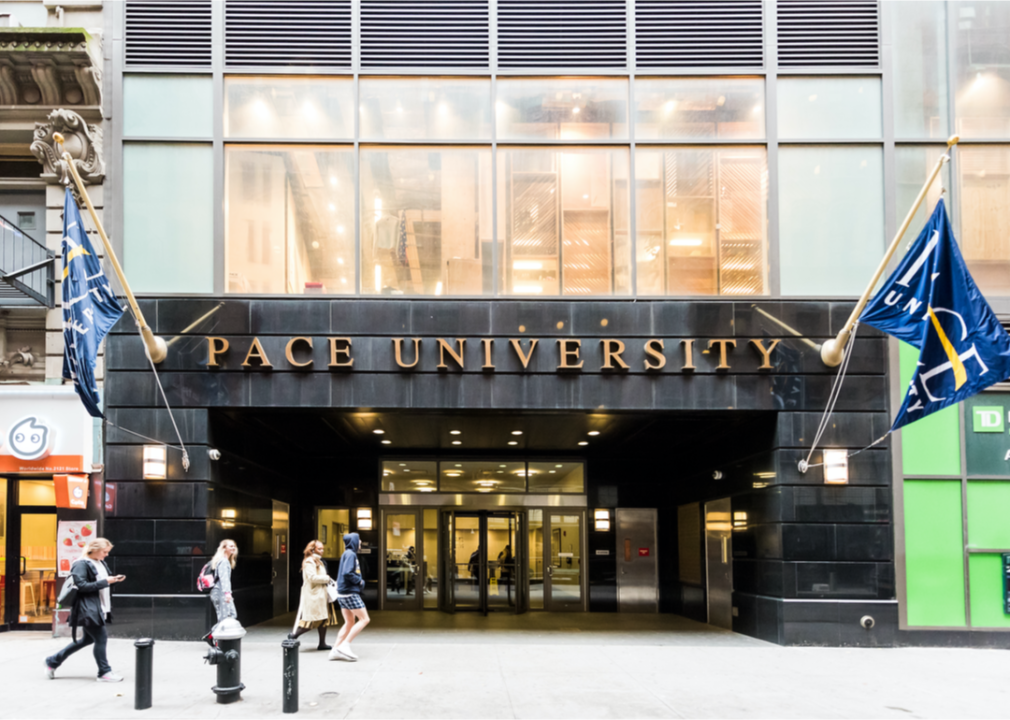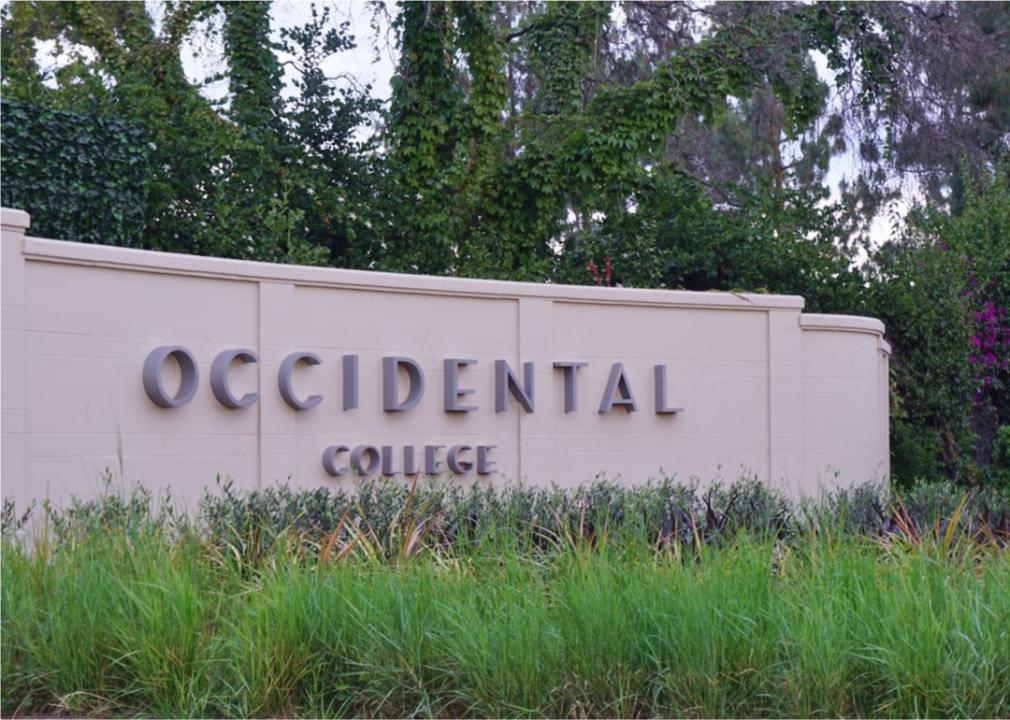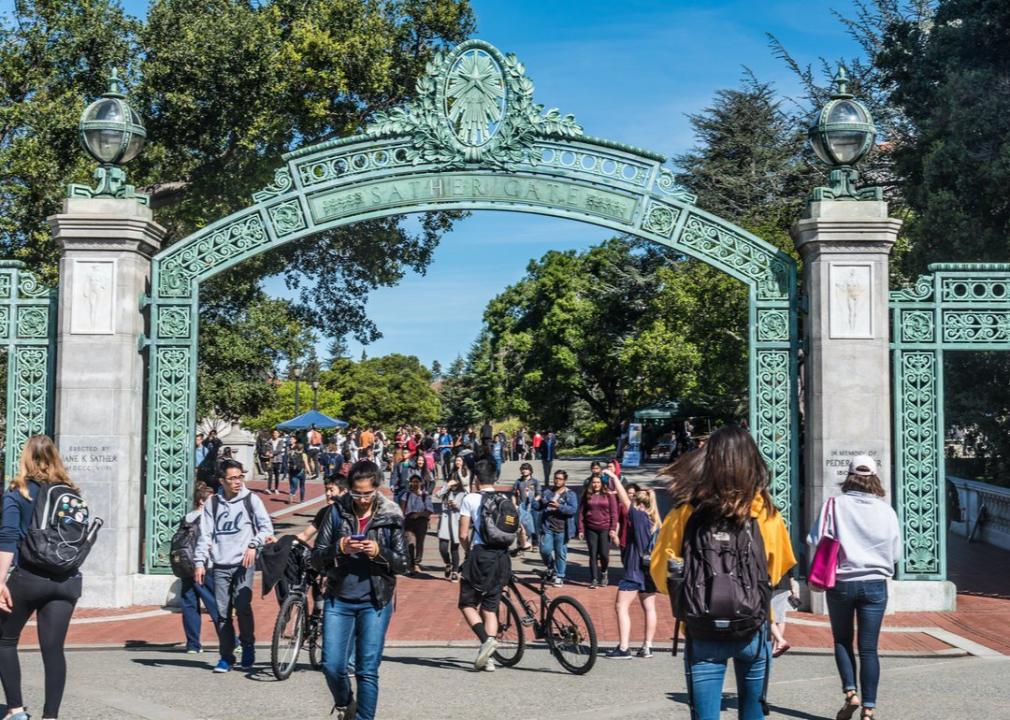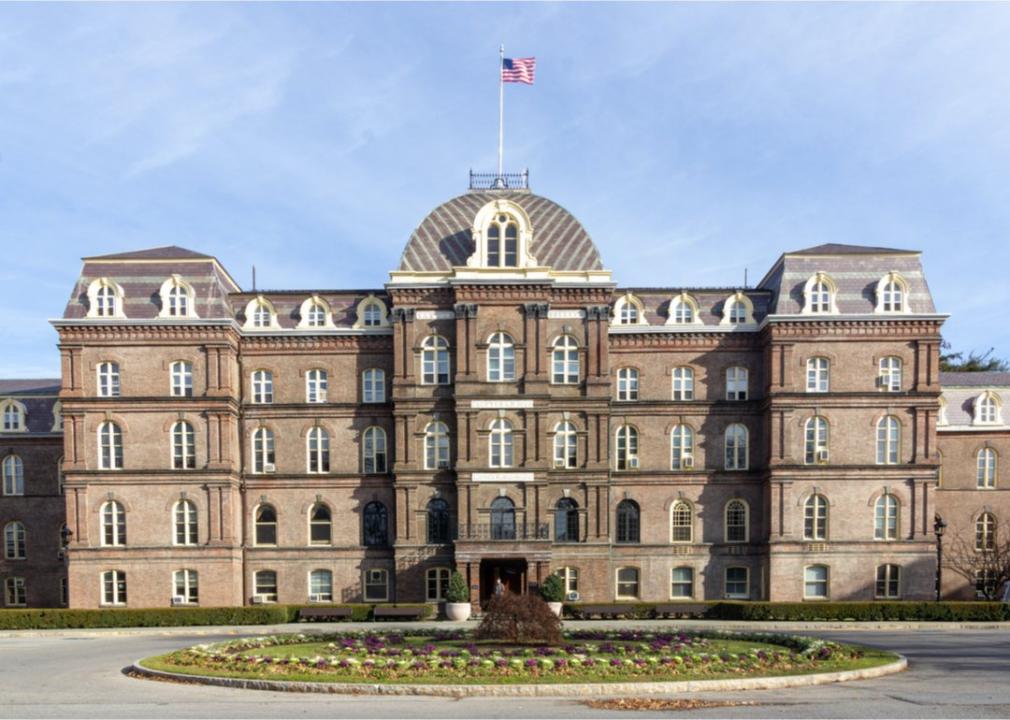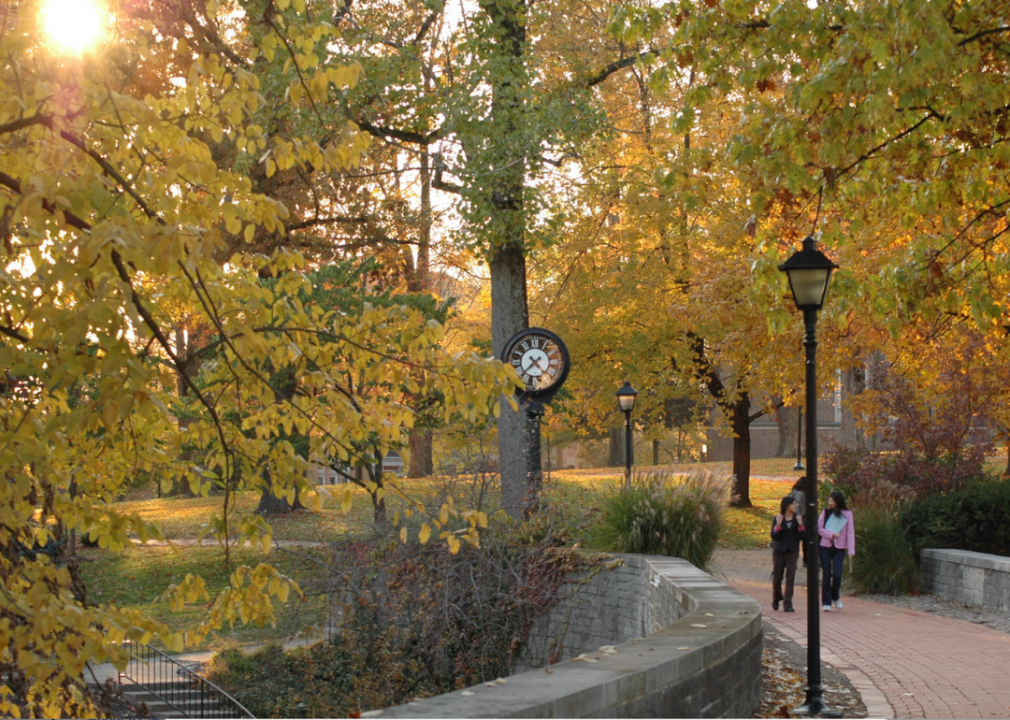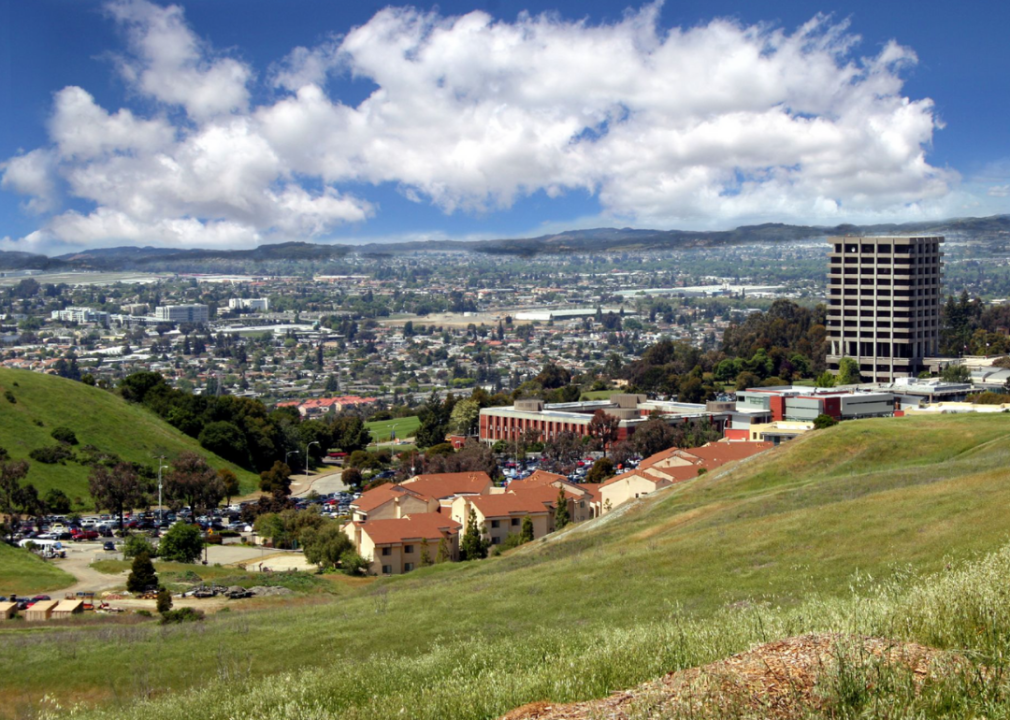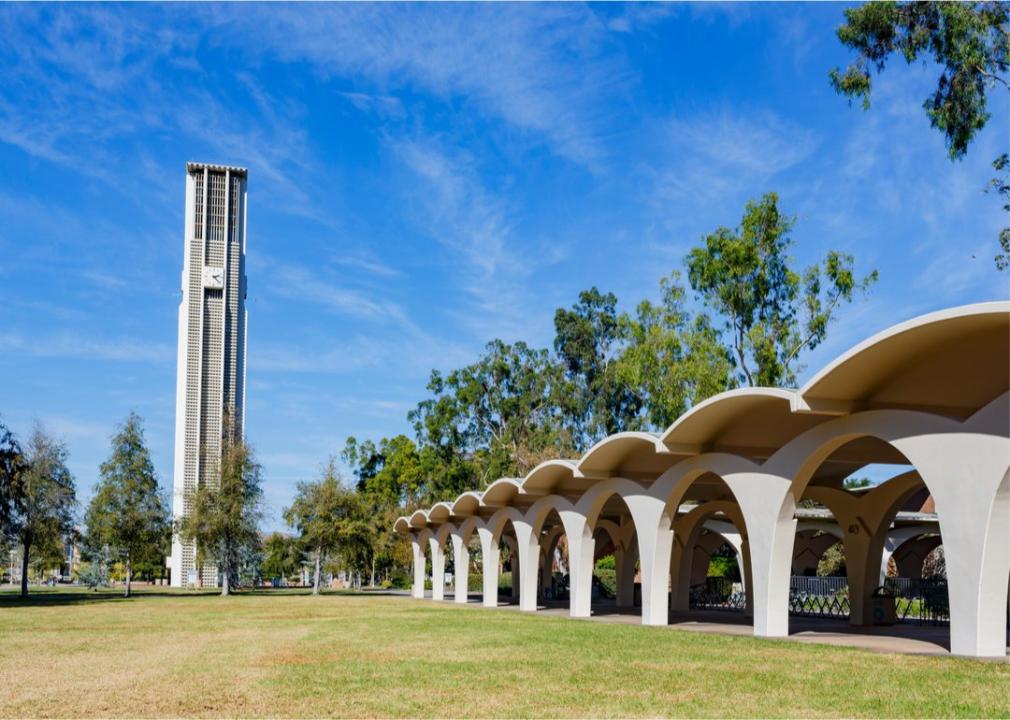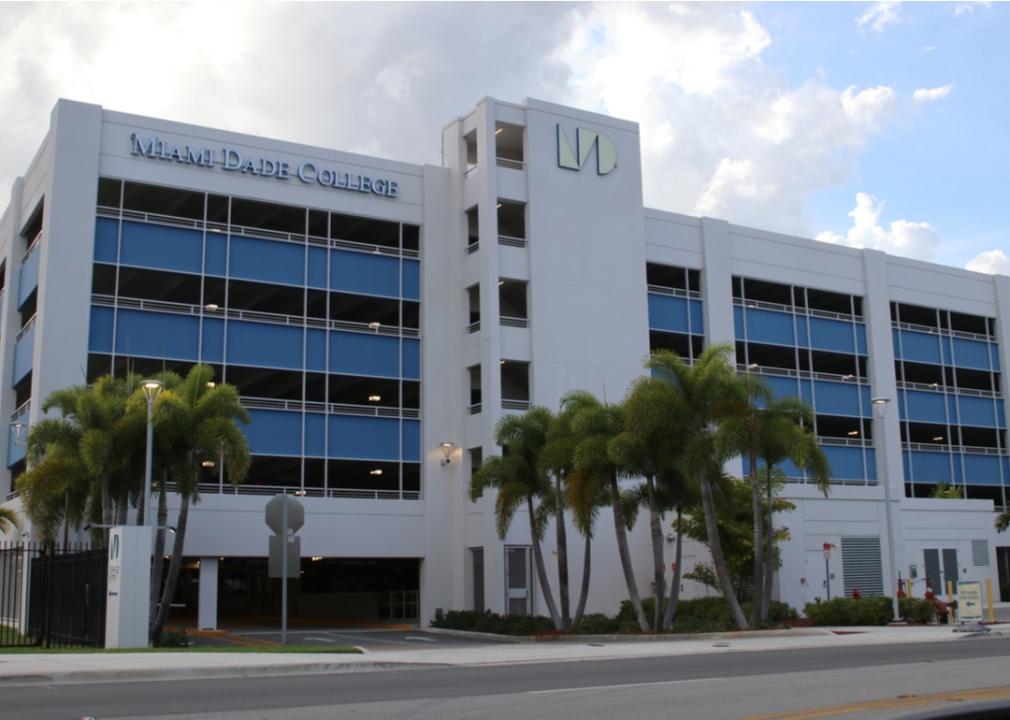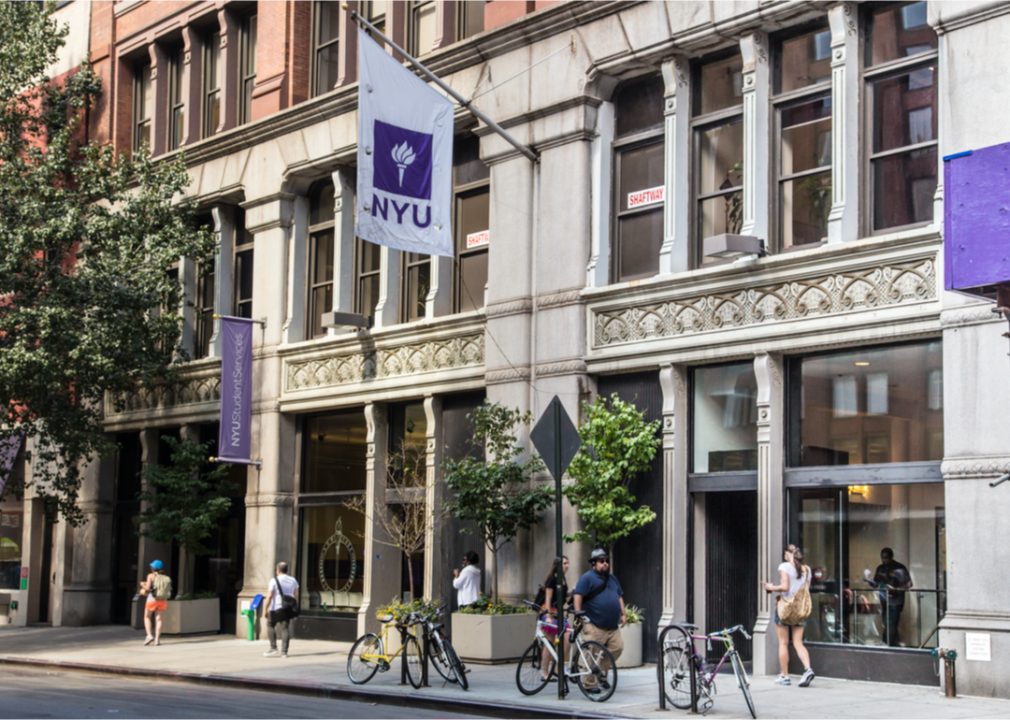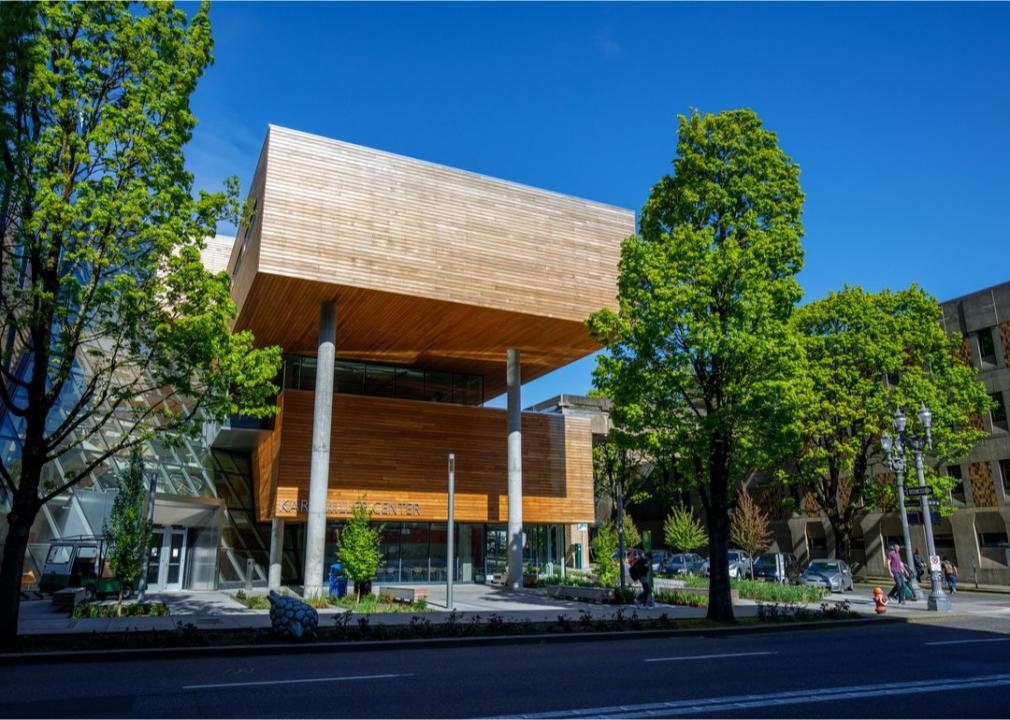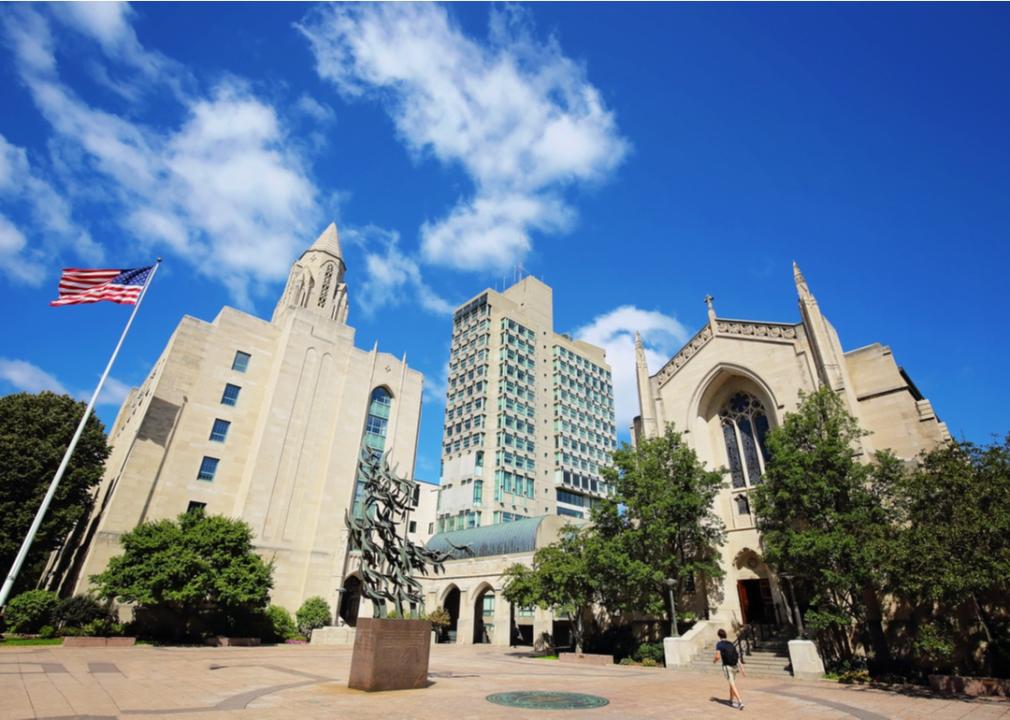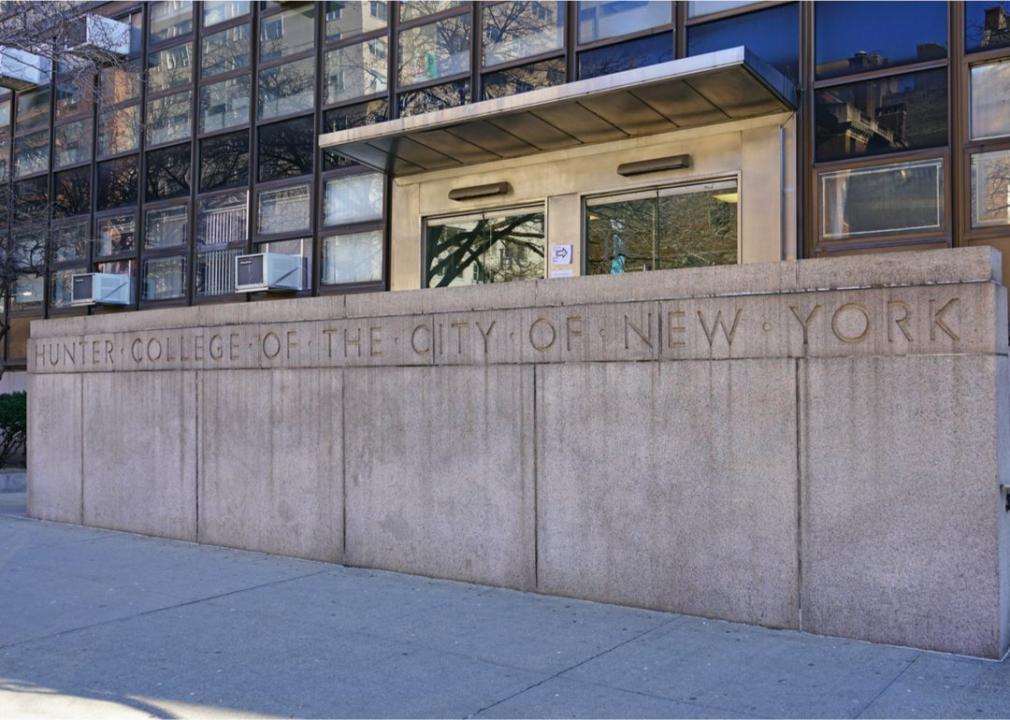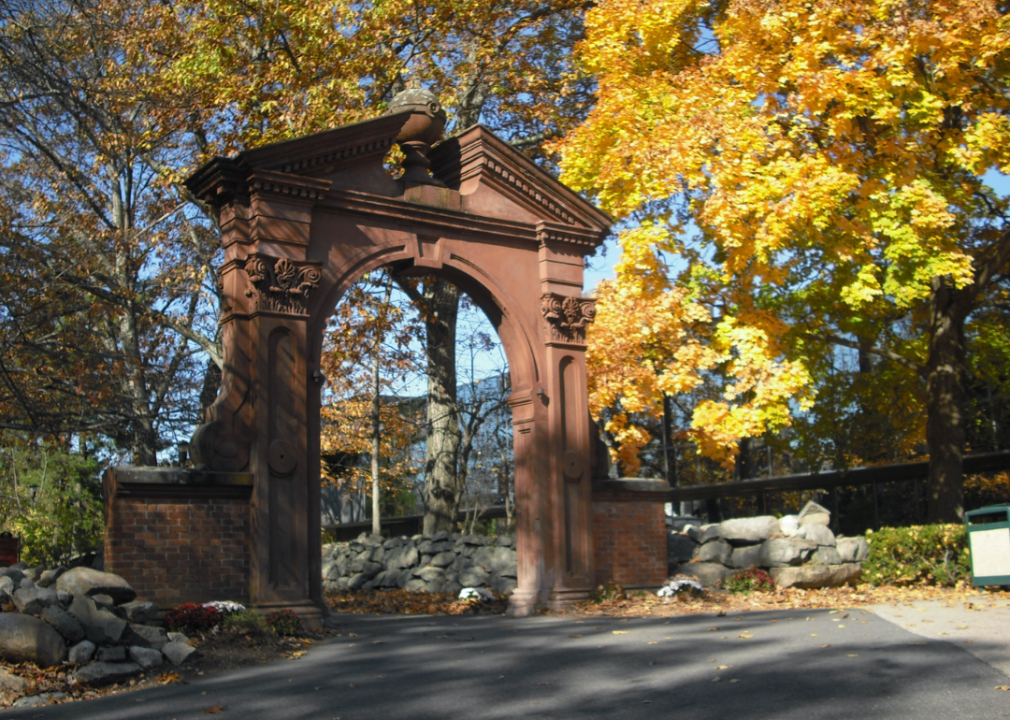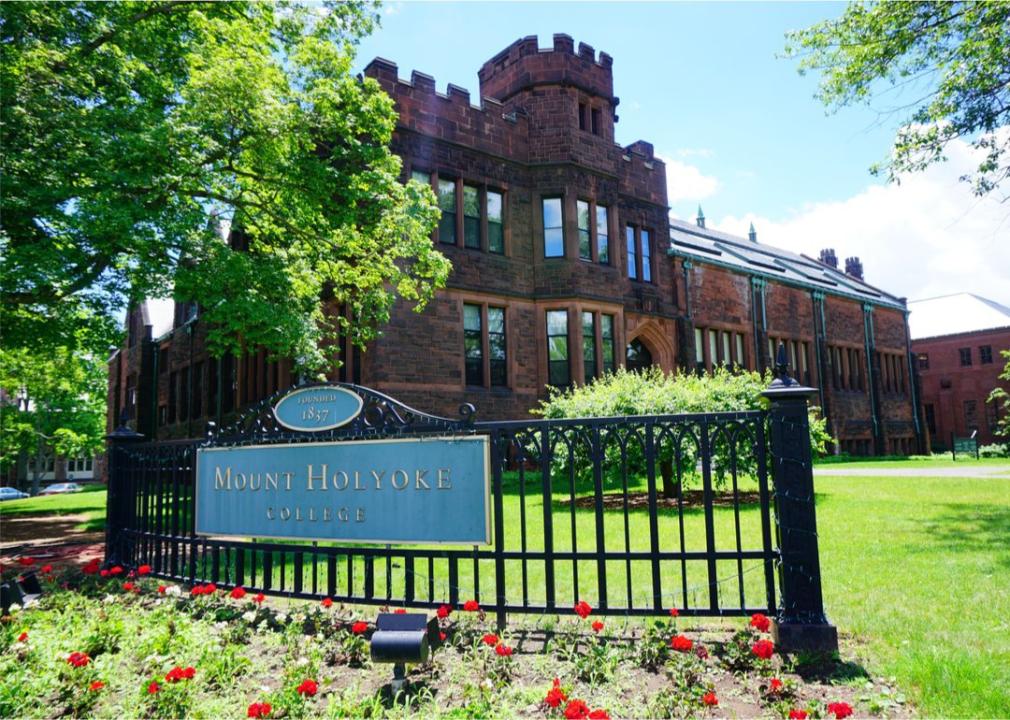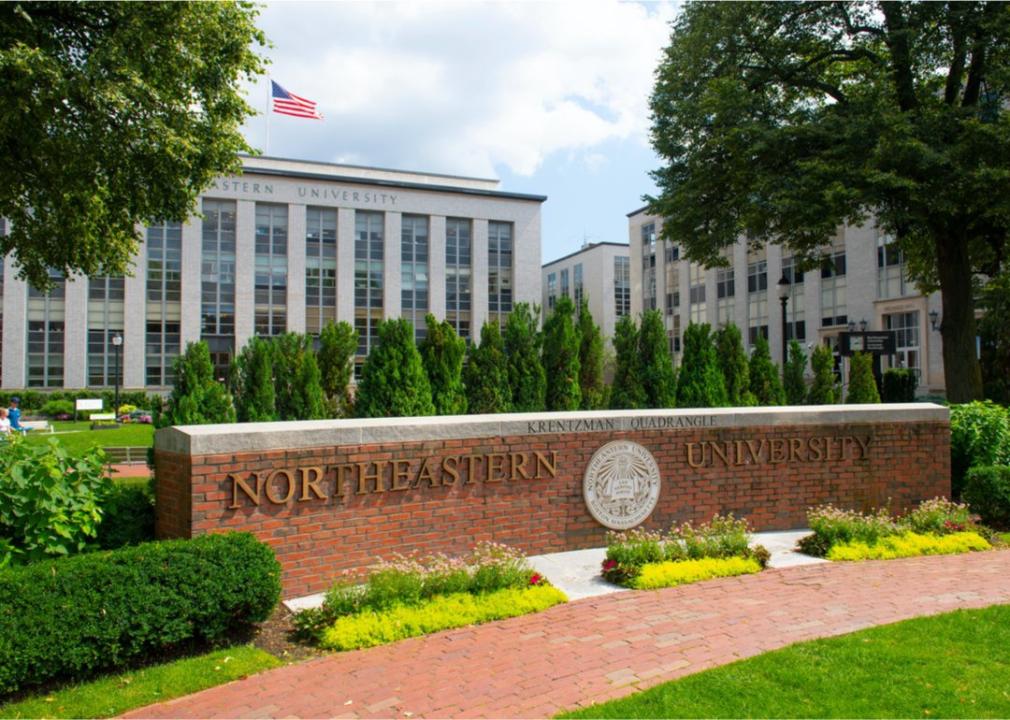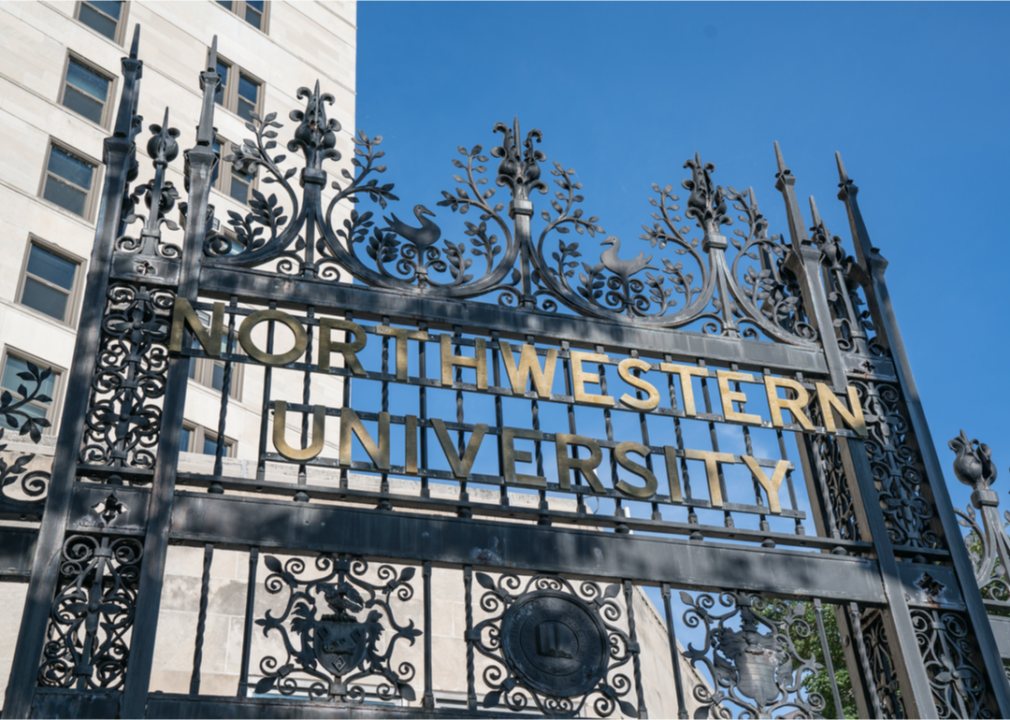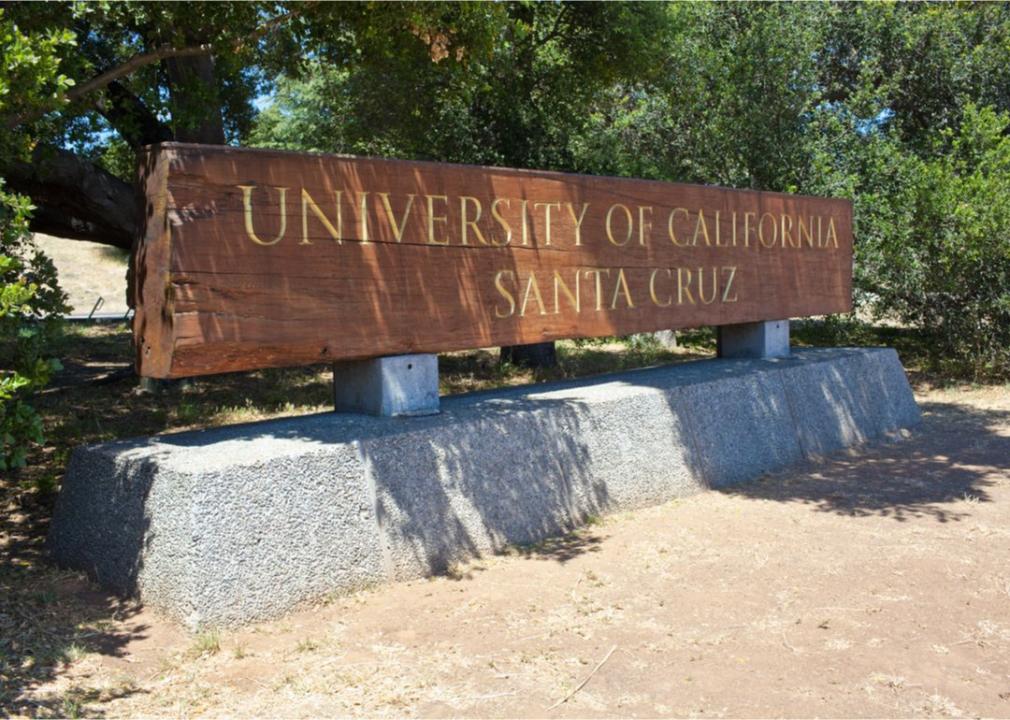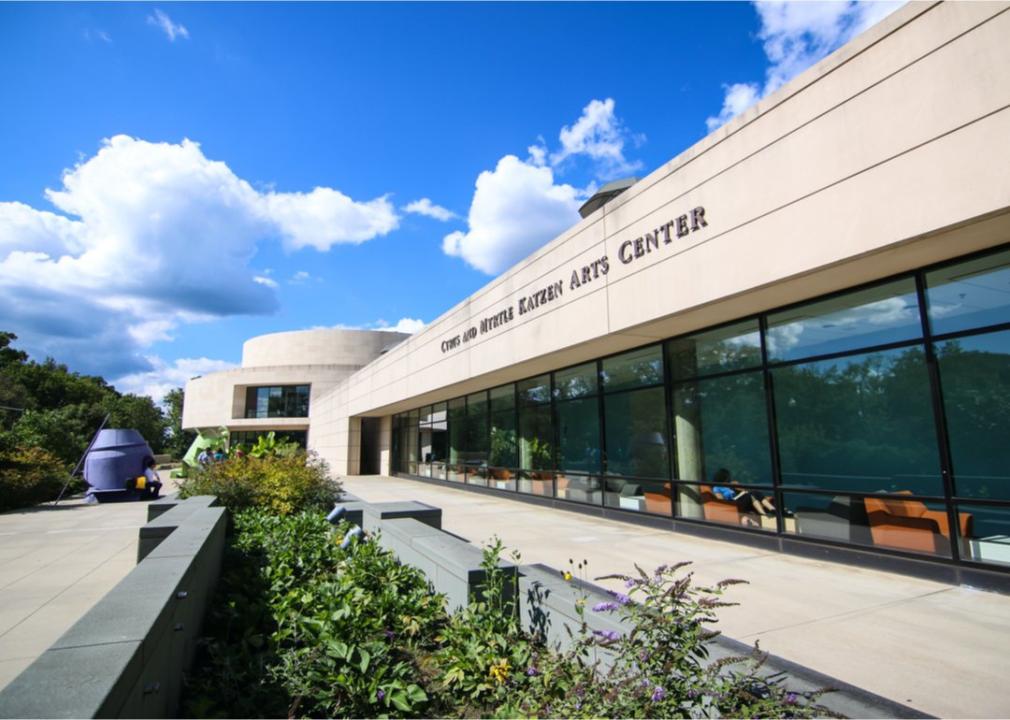Most liberal colleges in America
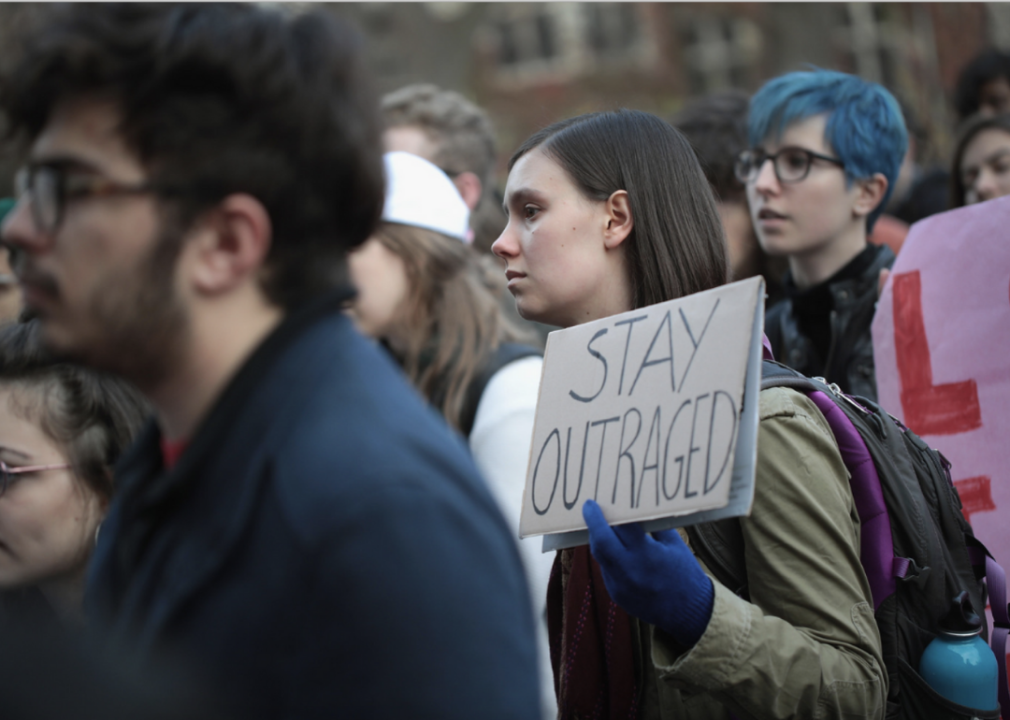
Scott Olson // Getty Images
Most liberal colleges in America
While there is no indisputable proof that there are more liberals than conservatives in academia—and while it is likely that arguments against political bias have more to do with ideological challenges than oppression—the perception that higher education is overwhelmingly liberal is a persistent one. A recurring theme in some conservative circles is that U.S. colleges are too liberal in general: Reporting from The Conversation holds that certain activists “have claimed that universities brainwash students and indoctrinate them into believing a liberal ideology.”
It is true, though, that some schools are more liberal than others. Just as there are purposely conservative schools, there also are schools that have a history of liberalism or progressive ideology, schools that exist in more liberal regions of the country, and schools that are progressive by design. These schools tend to be among the most prestigious, largest, and best-endowed schools in the United States.
Stacker consulted the Niche college explorer site in order to determine the 50 most liberal universities and colleges in America. For this gallery, we ranked schools’ liberalism based on students’ reviews of the schools’ campus communities. These reviews weighed the political leaning of the reviewer, if the reviewer attends or has attended the school, and the reviewer’s opinion of it.
Niche’s methodology considered students’ self-reported political leanings while at the college they currently or recently attend(ed); and the results of student surveys (data released and accurate as of January 2022) on campus political preferences, specifically liberal students’ opinions about the political leanings of students at the college they currently or recently attend(ed).
Keep reading to find out which schools are the country’s most liberal.
You may also like: Best private colleges in every state
![]()
Roman Tiraspolsky // Shutterstock
#50. CUNY John Jay College of Criminal Justice
– Location: New York, NY
– Students: 11,200 (student to faculty ratio: 18:1)
– Acceptance rate: 41% (ACT: data not available; SAT: 980-1130)
– Net price per year: $3,814
– Graduation rate: 52%
– Six-year median earnings: $44,900
A few liberal traditions overlap in CUNY John Jay College of Criminal Justice. It’s a public school located in the heart of a major city, with a focus on criminal justice combined with the eclectic liberal arts. The school is spread over several buildings in midtown Manhattan.
Ganna Tokolova // Shutterstock
#49. University of Southern California
– Location: Los Angeles, CA
– Students: 19,622 (student to faculty ratio: 9:1)
– Acceptance rate: 11% (ACT: 31-34; SAT: 1360-1530)
– Net price per year: $37,521
– Graduation rate: 92%
– Six-year median earnings: $74,000
The University of Southern California is private, despite the state-school style of name, and it’s one of California’s oldest universities with an established year of 1880. The school is highly selective, making it one of the West Coast’s most prestigious. There are over 50,000 students when you combine undergraduate and graduate students.
Bobak Ha’Eri // Wikimedia Commons
#48. Concordia College
– Location: Moorhead, MN
– Students: 1,956 (student to faculty ratio: 11:1)
– Acceptance rate: 68% (ACT: 21-27; SAT: 960-1340)
– Net price per year: $23,970
– Graduation rate: 72%
– Six-year median earnings: $44,500
Small Concordia College is a liberal arts college located in Moorhead, Minnesota, a city that borders Fargo, North Dakota, on their shared border. The school is private and Lutheran, with a curriculum that includes religious studies. The school was founded in 1891.
Clifflandis // Wikimedia Commons
#47. Clark Atlanta University
– Location: Atlanta, GA
– Students: 3,255 (student to faculty ratio: 19:1)
– Acceptance rate: 55% (ACT: 17-20; SAT: 940-1080)
– Net price per year: $27,931
– Graduation rate: 44%
– Six-year median earnings: $35,500
Clark Atlanta University was founded in 1865 and is a historically Black university. Overall, the historically Black colleges and universities (HBCUs) are more liberal than their majority white peers. Clark Atlanta is also situated in the bright blue city of Atlanta, which helped Joe Biden win the state by a less than 1% margin in the 2020 presidential election.
Bryan Pollard // Shuttterstock
#46. University of North Carolina – Greensboro
– Location: Greensboro, NC
– Students: 14,007 (student to faculty ratio: 16:1)
– Acceptance rate: 82% (ACT: 20-25; SAT: 1010-1180)
– Net price per year: $11,108
– Graduation rate: 59%
– Six-year median earnings: $37,500
The University of North Carolina – Greensboro is a liberal arts university founded in 1891. It’s a public school located in the diverse city of Greensboro, which has a large percentage of Black residents who tend to be more liberal voters. UNC-Greensboro is a Division I athletics school.
You may also like: 50 best private colleges ranked from least to most expensive
Kit Leong // Shutterstock
#45. Mount Saint Mary’s University – Los Angeles
– Location: Los Angeles, CA
– Students: 1,745 (student to faculty ratio: 10:1)
– Acceptance rate: 90% (ACT: 17-22; SAT: 920-1170)
– Net price per year: $29,708
– Graduation rate: 65%
– Six-year median earnings: $53,200
Private, Catholic Mount Saint Mary’s was founded in 1925. The school has a majority Latino student body, a demographic group that historically votes for Democratic candidates. Its peaceful, classical campus and Los Angeles location have made it a popular place to film TV shows and movies.
Popova Valeriya // Shutterstock
#44. Barnard College
– Location: New York, NY
– Students: 2,584 (student to faculty ratio: 9:1)
– Acceptance rate: 12% (ACT: 31-34; SAT: 1340-1520)
– Net price per year: $26,649
– Graduation rate: 92%
– Six-year median earnings: $57,900
Barnard College came to be in response to Columbia University—at the time—being all men. An independent affiliate of Columbia and today among the most-prestigious private women’s liberal arts schools, both schools share certain classes, clubs, and buildings. As one of the “Seven Sisters,” the school produced such well-known graduates as Martha Stewart, Joan Rivers, Ntozake Shange, Cynthia Nixon, and Zora Neale Hurston.
Roman Babakin // Shutterstock
#43. Temple University
– Location: Philadelphia, PA
– Students: 26,247 (student to faculty ratio: 13:1)
– Acceptance rate: 60% (ACT: 22-28; SAT: 1010-1230)
– Net price per year: $23,032
– Graduation rate: 74%
– Six-year median earnings: $50,500
Temple University is a public state university that was founded in 1884. It’s located in Philadelphia, a large blue city that is also part of the mostly liberal “Northeast megalopolis” that runs up through New York and Boston. Temple is known for its extensive research programs and for its professional schools.
Steve Cwik // Shutterstock
#42. Binghamton University, SUNY
– Location: Vestal, NY
– Students: 13,845 (student to faculty ratio: 19:1)
– Acceptance rate: 41% (ACT: 29-32; SAT: 1280-1440)
– Net price per year: $17,424
– Graduation rate: 82%
– Six-year median earnings: $61,600
Binghamton University is part of the State University of New York system, with campuses scattered in the central New York area that includes Binghamton. Influential comics artist Art Spiegelman attended the university before dropping out.
Jeffrey M. Frank // Shutterstock
#41. Tuskegee University
– Location: Tuskegee, AL
– Students: 2,254 (student to faculty ratio: 10:1)
– Acceptance rate: 52% (ACT: 18-23; SAT: 880-1100)
– Net price per year: $33,420
– Graduation rate: 52%
– Six-year median earnings: $35,500
Tuskegee is a historically Black university that was the longtime home to professor George Washington Carver. It was also the home base of the Tuskegee Airmen, an elite group of Black pilots who trained a few miles from the main campus.
You may also like: Best value colleges in America
Bob Pool // Shutterstock
#40. Willamette University
– Location: Salem, OR
– Students: 1,565 (student to faculty ratio: 11:1)
– Acceptance rate: 78% (ACT: 25-30; SAT: 1100-1330)
– Net price per year: $36,223
– Graduation rate: 69%
– Six-year median earnings: $51,100
Willamette University is a “College that Changes Lives,” with a high graduation rate compared with peer institutions. The undergraduate programs are complemented by a law school attended by just a few hundred students.
littlenySTOCK // Shutterstock
#39. CUNY Queens College
– Location: Queens, NY
– Students: 12,532 (student to faculty ratio: 16:1)
– Acceptance rate: 49% (ACT: data not available; SAT: 1040-1200)
– Net price per year: $4,471
– Graduation rate: 56%
– Six-year median earnings: $48,200
CUNY Queens College is part of the City University New York network, which has a total of 25 locations around the city. The city of New York is quite liberal anyway, but diverse Queens, with residents from all over the world, is even more so. Queens College was founded in 1937.
Tada Images // Shutterstock
#38. Academy of Art University
– Location: San Francisco, CA
– Students: 3,758 (student to faculty ratio: 14:1)
– Acceptance rate: 100% (ACT: data not available; SAT: data not available)
– Net price per year: $31,759
– Graduation rate: 45%
– Six-year median earnings: $38,600
Academy of Art University is a for-profit art school located in San Francisco. Popular wisdom holds that creative people like artists and actors tend to be liberal. That seems all the more true in very liberal San Francisco.
Ajay Suresh // Wikimedia Commons
#37. CUNY New York City College of Technology
– Location: Brooklyn, NY
– Students: 10,572 (student to faculty ratio: 18:1)
– Acceptance rate: 88% (ACT: data not available; SAT: 843-1030)
– Net price per year: $4,652
– Graduation rate: 18%
– Six-year median earnings: $40,600
In the heart of Brooklyn, CUNY New York City College of Technology offers both traditional and returning college students a practical and convenient educational option. The college was founded in 1946 as a path to meaningful careers for returning World War II soldiers.
Infrogmation of New Orleans // Shutterstock
#36. Dillard University
– Location: New Orleans, LA
– Students: 1,155 (student to faculty ratio: 13:1)
– Acceptance rate: 39% (ACT: 19-23; SAT: 980-1120)
– Net price per year: $17,269
– Graduation rate: 51%
– Six-year median earnings: $35,400
Dillard University in liberal New Orleans was founded in 1869 with other parts founded later on. It’s a historically Black university associated with both the United Church of Christ and the United Methodist Church. The school was damaged by Hurricane Katrina and temporarily relocated.
You may also like: 100 best community colleges in America
Jorge Salcedo // Shutterstock
#35. St. John Fisher College
– Location: Rochester, NY
– Students: 2,535 (student to faculty ratio: 11:1)
– Acceptance rate: 64% (ACT: 21-26; SAT: 1070-1260)
– Net price per year: $28,468
– Graduation rate: 75%
– Six-year median earnings: $47,800
Located in the Rochester suburb of Pittsford, St. John Fisher College was founded in 1948. The school is named after a Catholic saint, John Fisher, who briefly served as Cardinal of Kent before he was martyred. Appropriately, the school’s athletic mascot is the cardinal.
PhillipJR // Shutterstock
#34. Emerson College
– Location: Boston, MA
– Students: 3,827 (student to faculty ratio: 15:1)
– Acceptance rate: 33% (ACT: 27-31; SAT: 1200-1410)
– Net price per year: $46,381
– Graduation rate: 82%
– Six-year median earnings: $46,600
Small, private Emerson College was founded in 1880. The school is named not for Ralph Waldo Emerson but for Charles Wesley Emerson, a distant cousin who lived about a generation later. The college has an especially robust theater program including several prominent Boston theater venues.
Kevin D. Walsh // Shutterstock
#33. Tufts University
– Location: Medford, MA
– Students: 5,742 (student to faculty ratio: 9:1)
– Acceptance rate: 15% (ACT: 32-34; SAT: 1390-1540)
– Net price per year: $26,280
– Graduation rate: 94%
– Six-year median earnings: $75,800
Located in inner suburban Boston, Tufts has a long history of robust research and an emphasis on public service. Actor Peter Gallagher is a noted alumnus, while fellow actor Rainn Wilson is a noted dropout.
https://www.shutterstock.com/editor/image/autumn-colors-tufts-university-2017090
James Kirkikis // Shutterstock
#32. San Jose State University
– Location: San Jose, CA
– Students: 23,593 (student to faculty ratio: 25:1)
– Acceptance rate: 64% (ACT: 18-27; SAT: 1020-1260)
– Net price per year: $14,471
– Graduation rate: 64%
– Six-year median earnings: $56,100
In 2019, San Jose State University opened a food pantry for its neediest students, according to NBC. Any enrolled student with an annual income of less than $33,000 may use the pantry once a week to ensure they have access to the nutrition they need.
Taylor & Burns // Wikimedia Commons
#31. Bennington College
– Location: Bennington, VT
– Students: 686 (student to faculty ratio: 10:1)
– Acceptance rate: 61% (ACT: data not available; SAT: data not available)
– Net price per year: $38,386
– Graduation rate: 76%
– Six-year median earnings: $29,500
Bennington boasts a high number of famous alums and instructors, especially relative to its size. These include gender theorist Judith Butler, feminist theorist Andrea Dworkin, and critic Camille Paglia.
You may also like: Colleges with the best student life in every state
Lissandra Melo // Shutterstock
#30. University of San Francisco
– Location: San Francisco, CA
– Students: 6,345 (student to faculty ratio: 13:1)
– Acceptance rate: 64% (ACT: 23-29; SAT: 1130-1330)
– Net price per year: $38,422
– Graduation rate: 75%
– Six-year median earnings: $62,300
The University of San Francisco recently announced its achievement of carbon neutrality more than 30 years ahead of its 2050 target. This means the school offsets the carbon it uses, effectively casting a virtually invisible carbon footprint. The school did this by embracing green cleaning products, installing microturbines for heat and energy, and buying energy offsets, among other things.
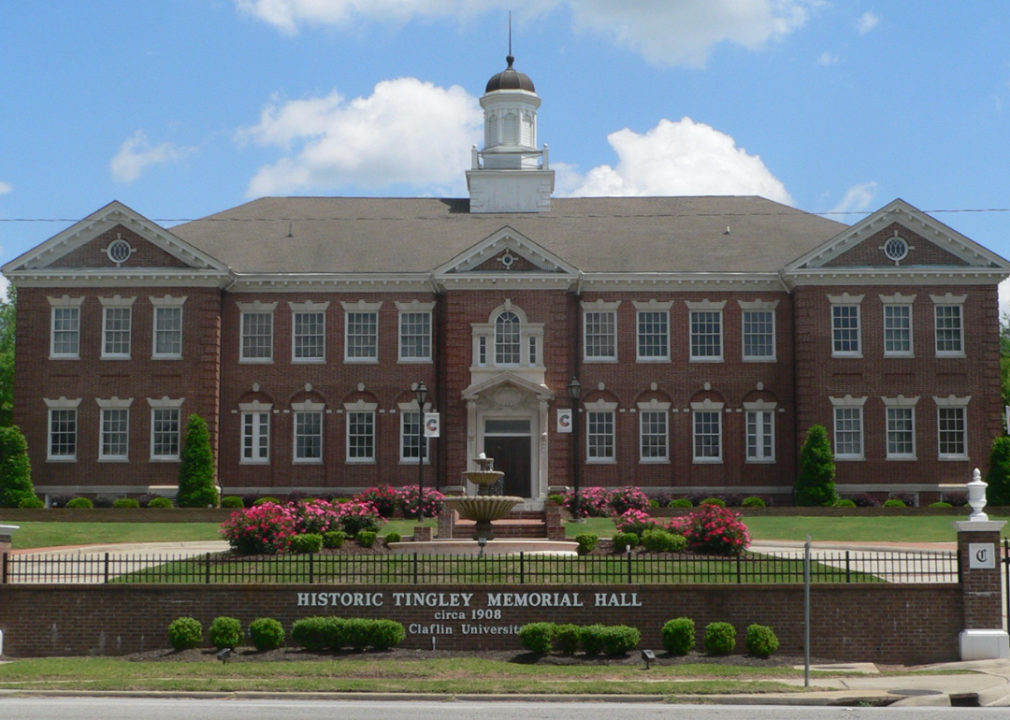
Ammodramus // Wikimedia Commons
#29. Claflin University
– Location: Orangeburg, SC
– Students: 1,889 (student to faculty ratio: 13:1)
– Acceptance rate: 55% (ACT: 15-19; SAT: 830-1050)
– Net price per year: $18,136
– Graduation rate: 51%
– Six-year median earnings: $28,500
Claflin University is a historically Black university also linked with the United Methodist Church. It was founded just after the U.S. Civil War and is South Carolina’s oldest HBCU, with a series of notable Methodist bishops among its alumni.
Jim Feliciano // Shutterstock
#28. California State University – San Bernardino
– Location: San Bernardino, CA
– Students: 16,549 (student to faculty ratio: 29:1)
– Acceptance rate: 69% (ACT: 15-19; SAT: 910-1090)
– Net price per year: $7,876
– Graduation rate: 55%
– Six-year median earnings: $44,500
California State University – San Bernardino was founded in 1965, making it one of the newest universities on this list. CSU San Bernardino is unusual in the University of California system for offering both Arabic language and Islamic history as part of its curriculum. The school has a popular business program.
f11 photo // Shutterstock
#27. University of Washington
– Location: Seattle, WA
– Students: 29,332 (student to faculty ratio: 20:1)
– Acceptance rate: 52% (ACT: 27-33; SAT: 1220-1470)
– Net price per year: $10,692
– Graduation rate: 84%
– Six-year median earnings: $57,700
A graduate student team from the University of Washington won a 2019 competition for environmental innovation. The team discovered a way to make batteries degrade more slowly over time, allowing them to stay useful longer. “If you can fix batteries, it has an impact on so many other clean energy technologies,” said Elizabeth Rasmussen, founder of MOtiF Materials, the University of Washington team.
Andriy Blokhin // Shutterstock
#26. Pace University
– Location: New York, NY
– Students: 7,837 (student to faculty ratio: 15:1)
– Acceptance rate: 79% (ACT: 21-27; SAT: 1050-1230)
– Net price per year: $32,492
– Graduation rate: 57%
– Six-year median earnings: $60,300
Pace University is the umbrella name for a collection of schools based in New York City and upstate, covering everything from undergraduate liberal arts to the MFA drama program home to “Inside the Actors Studio.” Alumni include “Sopranos” star Vincent Pastore and celebrity chef Rachael Ray.
You may also like: Most liberal colleges in America
EQRoy // Shutterstock
#25. Occidental College
– Location: Los Angeles, CA
– Students: 1,962 (student to faculty ratio: 9:1)
– Acceptance rate: 37% (ACT: 28-32; SAT: 1300-1480)
– Net price per year: $35,362
– Graduation rate: 86%
– Six-year median earnings: $50,600
Occidental College is the oldest liberal arts college on the West Coast. The school graduated Terry Gilliam, Jack Kemp, George Edward Alcorn, Jr., and former President Barack Obama, and actors Ben Affleck and Luke Wilson also took courses there.
David A Litman // Shutterstock
#24. University of California – Berkeley
– Location: Berkeley, CA
– Students: 29,991 (student to faculty ratio: 19:1)
– Acceptance rate: 16% (ACT: 31-35; SAT: 1330-1530)
– Net price per year: $18,522
– Graduation rate: 93%
– Six-year median earnings: $64,700
The University of California, Berkeley, has been the symbol of the progressive movement for at least the second half of the 20th century. The campus was instrumental in the Free Speech Movement of 1964, opposition to the Vietnam War, and the People’s Park Protest of 1969—where the National Guard was called against the student protesters.
Brian Logan Photography // Shutterstock
#23. Vassar College
– Location: Poughkeepsie, NY
– Students: 2,424 (student to faculty ratio: 8:1)
– Acceptance rate: 24% (ACT: 31-34; SAT: 1370-1520)
– Net price per year: $24,811
– Graduation rate: 91%
– Six-year median earnings: $54,600
One of the “Seven Sisters,” Vassar College is among the most-selective schools in the nation. Once an all-women school, Vassar became coeducational in 1969. Meryl Streep, Anthony Bourdain, Jacqueline Kennedy Onassis, Jane Fonda, and Anne Hathaway are all alumni.
Pbass1956 // Wikimedia Commons
#22. Denison University
– Location: Granville, OH
– Students: 2,263 (student to faculty ratio: 9:1)
– Acceptance rate: 29% (ACT: 27-31; SAT: 1200-1410)
– Net price per year: $36,650
– Graduation rate: 82%
– Six-year median earnings: $48,800
The 2019 passing of former U.S. Sen. Richard Lugar was hard on the Denison University community, as Luger was an alumnus (class of 1954) and a trustee of the school. “Lugar was a great Denisonian and human being. He lived the mission of the college, and in doing so, he made the world a better place,” Denison President Adam Weinberg said in a statement released by the university.
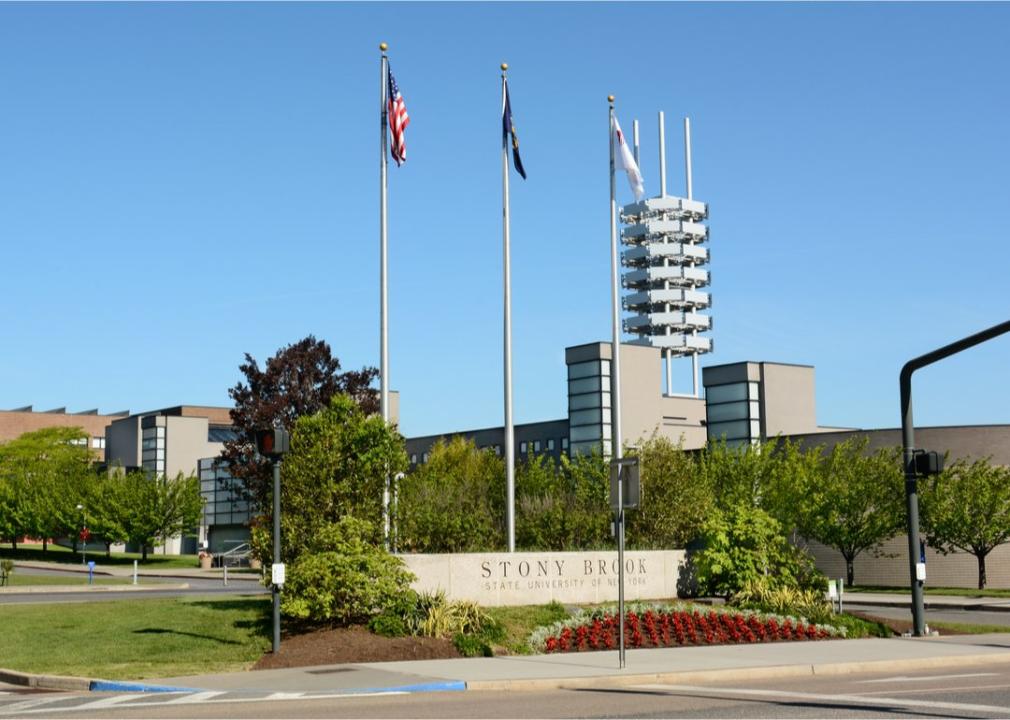
Steve Cukrov // Shutterstock
#21. Stony Brook University, SUNY
– Location: Stony Brook, NY
– Students: 16,697 (student to faculty ratio: 19:1)
– Acceptance rate: 44% (ACT: 26-32; SAT: 1230-1440)
– Net price per year: $15,605
– Graduation rate: 76%
– Six-year median earnings: $57,600
New York’s Stony Brook University has a prestigious graduate school system that produces tons of cutting-edge research, like recent findings about brain conditions among 9/11 first responders. The Long Island institution is part of New York’s robust State University of New York system.
You may also like: Can you solve these real ‘Jeopardy!’ clues about college?
Jennifer Williams // Wikimedia Commons
#20. California State University – East Bay
– Location: Hayward, CA
– Students: 10,635 (student to faculty ratio: 26:1)
– Acceptance rate: 76% (ACT: 16-21; SAT: 800-1020)
– Net price per year: $10,902
– Graduation rate: 50%
– Six-year median earnings: $51,700
Cal State East Bay is found in the diverse community of Hayward, which experienced a heyday of industrial food production decades ago. The recent death of baseball legend and commentator Joe Morgan was especially big news for this school—his alma mater.
Kit Leong // Shutterstock
#19. University of California – Riverside
– Location: Riverside, CA
– Students: 21,652 (student to faculty ratio: 22:1)
– Acceptance rate: 57% (ACT: 23-30; SAT: 1130-1330)
– Net price per year: $13,045
– Graduation rate: 76%
– Six-year median earnings: $49,700
In 2019, the University of California-Riverside announced that the school has received a grant from NASA’s Translational Research Institute for Space Health. The grant, valued at $800,000, will be used to study how to make vegetable crops suitable for growth on the International Space Station.
Eric Glenn // Shutterstock
#18. Miami Dade College
– Location: Miami, FL
– Students: 21,473 (student to faculty ratio: 19:1)
– Acceptance rate: 100% (ACT: data not available; SAT: data not available)
– Net price per year: $4,947
– Graduation rate: 33%
– Six-year median earnings: $31,100
Miami Dade College is the collective name for a system of eight campuses in Miami-Dade County, the portion of the greater Miami and Ft. Lauderdale area that is heavily Latino. In 2020, the college system received a combined $14 million in grant money for Developing Hispanic-Serving Institutions.
Monkey Business Images // Shutterstock
#17. Fayetteville State University
– Location: Fayetteville, NC
– Students: 4,071 (student to faculty ratio: 18:1)
– Acceptance rate: 69% (ACT: 17-21; SAT: 870-1010)
– Net price per year: $5,587
– Graduation rate: 34%
– Six-year median earnings: $31,200
Fayetteville is often cited as one of the liberal bastions within North Carolina, and Fayetteville State University extends that reputation into education. The university’s undergraduate programs serve students of all ability levels, including those of traditional college age as well as returning adults.
Eric Glenn // Shutterstock
#16. Howard University
– Location: Washington, DC
– Students: 6,269 (student to faculty ratio: 10:1)
– Acceptance rate: 36% (ACT: 22-27; SAT: 1130-1280)
– Net price per year: $21,428
– Graduation rate: 65%
– Six-year median earnings: $49,200
The national capital’s HBCU (Historically Black Colleges and Universities), Howard University is a top-tier research university—the only one currently in the HBCU system. It is also one of the most selective schools for minority students and a top 25 law school for placing graduates in successful law firms.
You may also like: 25 oldest colleges in America
littlenySTOCK // Shutterstock
#15. New York University
– Location: New York, NY
– Students: 25,872 (student to faculty ratio: 9:1)
– Acceptance rate: 16% (ACT: 30-34; SAT: 1350-1530)
– Net price per year: $37,739
– Graduation rate: 85%
– Six-year median earnings: $61,900
Greenwich Village’s New York University is the spiritual competitor to Columbia University. The school’s research has redefined our understanding of the world, as reflected in the 2019 news about research that humans evolved from ground-dwelling apes rather than primates that lived in trees.
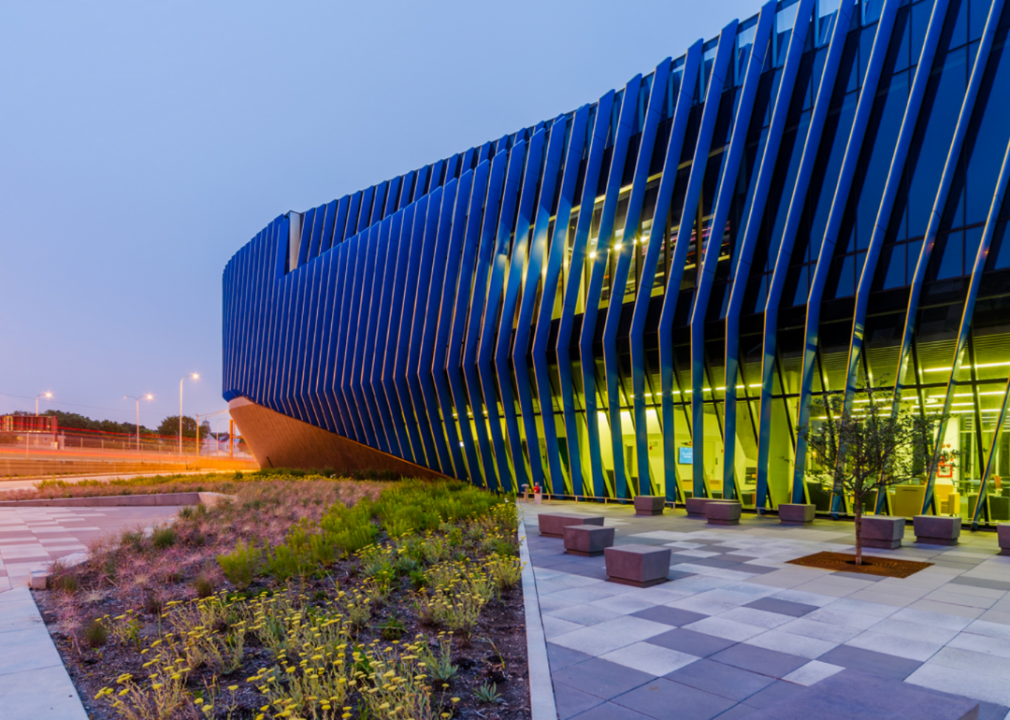
Serhii // Wikimedia Commons
#14. Northeastern Illinois University
– Location: Chicago, IL
– Students: 3,294 (student to faculty ratio: 13:1)
– Acceptance rate: 58% (ACT: 15-22; SAT: 910-1120)
– Net price per year: $14,941
– Graduation rate: 21%
– Six-year median earnings: $37,900
Deeply diverse Northeastern Illinois University is a Hispanic Serving Institution and one of the most upwardly mobile universities in the country. The undergraduate programs include older working adults as well as those of traditional college age, mixing liberal arts with preprofessional studies and even certificate programs.
ARTYOORAN // Shutterstock
#13. Portland State University
– Location: Portland, OR
– Students: 13,949 (student to faculty ratio: 21:1)
– Acceptance rate: 96% (ACT: 18-24; SAT: 1000-1220)
– Net price per year: $12,710
– Graduation rate: 48%
– Six-year median earnings: $44,700
Portland State University was created as a post-secondary educational option for returning World War II veterans. It is the only public university in Oregon near a city center. The university has developed partnerships with Intel and Portland General Electric.
Canva
#12. West Chester University of Pennsylvania
– Location: West Chester, PA
– Students: 13,044 (student to faculty ratio: 19:1)
– Acceptance rate: 75% (ACT: 20-26; SAT: 1030-1210)
– Net price per year: $19,348
– Graduation rate: 77%
– Six-year median earnings: $48,400
Jill Biden earned her master’s degree at West Chester University, a public research university in the area just west of Philadelphia. It belongs to a consortium of public Pennsylvania universities that stretches all the way to Edinboro University of Pennsylvania in the other corner of the state.
eskystudio // Shutterstock
#11. Boston University
– Location: Boston, MA
– Students: 16,978 (student to faculty ratio: 10:1)
– Acceptance rate: 19% (ACT: 30-34; SAT: 1340-1510)
– Net price per year: $29,479
– Graduation rate: 88%
– Six-year median earnings: $65,300
The largest school in New England, Boston University is emblematic of the city it’s in: Many of its buildings are recognizable landmarks. The alma mater of the Rev. Dr. Martin Luther King Jr.—where he received his Ph.D. in systematic theology in 1955—also boasts an alumni roster that includes Alexander Graham Bell, Elie Wiesel, Isaac Asimov, Saul Bellow, President William Howard Taft, Julianne Moore, Marisa Tomei, and Howard Stern.
You may also like: College majors that make the most money
ESB Professional // Shutterstock
#10. Adelphi University
– Location: Garden City, NY
– Students: 5,063 (student to faculty ratio: 11:1)
– Acceptance rate: 74% (ACT: 21-27; SAT: 1060-1250)
– Net price per year: $28,130
– Graduation rate: 73%
– Six-year median earnings: $58,500
Adelphi University is based in Long Island’s Garden City but has campuses in other New York locations. Public Enemy’s Chuck D and Flavor Flav met as students there in the 1980s.
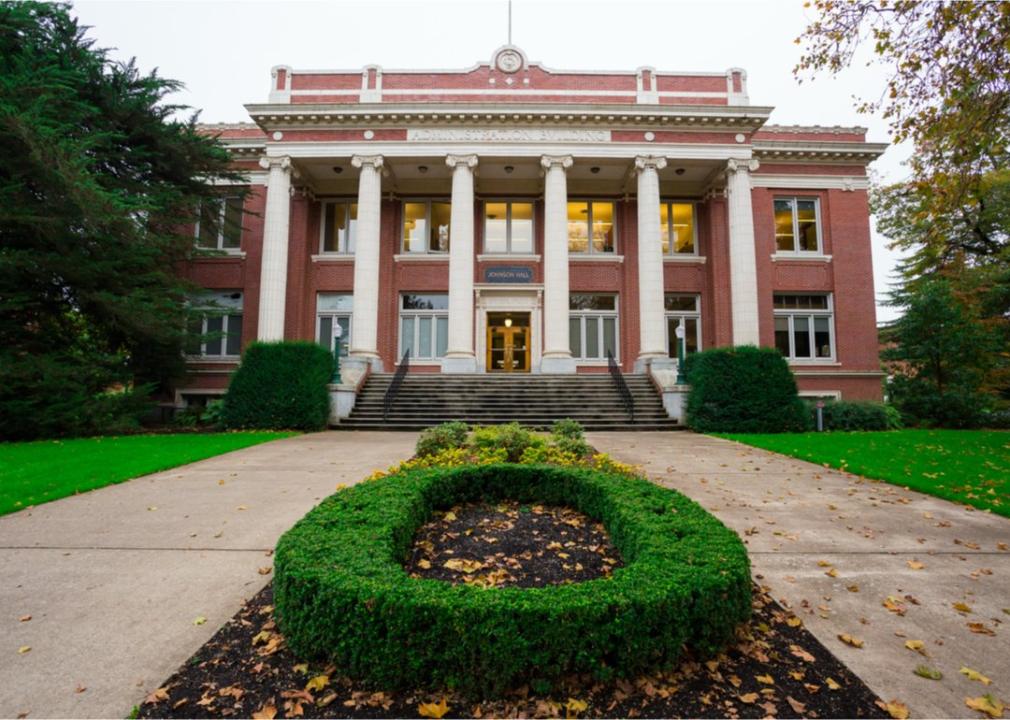
Joshua Rainey Photography // Shutterstock
#9. University of Oregon
– Location: Eugene, OR
– Students: 17,419 (student to faculty ratio: 17:1)
– Acceptance rate: 82% (ACT: 22-28; SAT: 1100-1310)
– Net price per year: $16,080
– Graduation rate: 74%
– Six-year median earnings: $44,800
Another hipster-friendly environment, Eugene plays host to the University of Oregon. The university’s Phil and Penny Knight Campus for Accelerating Scientific Impact was funded in part by the single-largest gift ever given to a public university.
EQRoy // Shutterstock
#8. CUNY Hunter College
– Location: New York, NY
– Students: 12,991 (student to faculty ratio: 13:1)
– Acceptance rate: 35% (ACT: data not available; SAT: 1170-1350)
– Net price per year: $3,957
– Graduation rate: 57%
– Six-year median earnings: $47,200
Hunter College in New York City has distinguished itself as a center of excellence with the inclusion of two women Nobel Laureates in medicine on its alumni list. The school also boasts alums Vin Diesel, Hugh Downs, Rhea Perlman, Robert Altman, Donna Shalala, and Judy Reyes.
Daniellek0512 // Shutterstock
#7. Ramapo College of New Jersey
– Location: Mahwah, NJ
– Students: 4,870 (student to faculty ratio: 16:1)
– Acceptance rate: 66% (ACT: 20-27; SAT: 1030-1230)
– Net price per year: $16,823
– Graduation rate: 72%
– Six-year median earnings: $53,200
Ramapo College is only about 50 years old, making it one of the youngest schools on the list. It sprang up in response to development in the surrounding suburban area, and as a small (but public) liberal arts college, it appeals to a different demographic than local community colleges or larger public universities.
Feng Cheng // Shutterstock
#6. Mount Holyoke College
– Location: South Hadley, MA
– Students: 2,157 (student to faculty ratio: 9:1)
– Acceptance rate: 38% (ACT: 29-32; SAT: 1290-1500)
– Net price per year: $32,008
– Graduation rate: 83%
– Six-year median earnings: $48,600
Mount Holyoke College placed its police chief on administrative leave in 2019 following protests when it was discovered that the chief liked Twitter posts that featured Donald Trump calling to “BUILD THAT WALL” and the NRA wishing a “Merry Christmas.” The protests were triggered when a staffer at nearby Smith College called campus police on a Black student worker on her lunch break. The chief heads a joint police department serving both Mount Holyoke and Smith campuses.
You may also like: 50 college majors that earn the least money
Wangkun Jia // Shutterstock
#5. Northeastern University
– Location: Boston, MA
– Students: 14,156 (student to faculty ratio: 14:1)
– Acceptance rate: 18% (ACT: 32-35; SAT: 1390-1540)
– Net price per year: $36,479
– Graduation rate: 89%
– Six-year median earnings: $67,400
Boston has more than its share of first-class universities. Northeastern University is Boston’s research university, relying on a cooperative educational model—which pairs classroom work with professional experiences, such as internships—to offer a complete educational experience. It is one of the leading schools in the world for co-op education and internships.
Paul Brady Photography // Shutterstock
#4. Northwestern University
– Location: Evanston, IL
– Students: 8,284 (student to faculty ratio: 6:1)
– Acceptance rate: 9% (ACT: 33-35; SAT: 1440-1550)
– Net price per year: $26,196
– Graduation rate: 94%
– Six-year median earnings: $69,000
Illinois’ marquee research university, Northwestern University, draws in more than $700 million in sponsored research each year, according to the school’s website. The university is a founding member of the Big Ten Conference and the only private university currently part of the conference. It also has the ninth-largest endowment in the United States, valued at more than $11 billion.
Matthew Corley // Shutterstock
#3. University of California – Santa Cruz
– Location: Santa Cruz, CA
– Students: 16,994 (student to faculty ratio: 25:1)
– Acceptance rate: 51% (ACT: 26-32; SAT: 1200-1380)
– Net price per year: $17,889
– Graduation rate: 75%
– Six-year median earnings: $46,900
Created as a center for progressive, cross-discipline education, the university is designed to give the feel of small, intimate colleges inside a large university. Among the more popular majors are critical race and ethnic studies and the history of consciousness.
Bob LoCicero // Shutterstock
#2. University of Vermont
– Location: Burlington, VT
– Students: 10,501 (student to faculty ratio: 16:1)
– Acceptance rate: 67% (ACT: 26-31; SAT: 1180-1360)
– Net price per year: $19,185
– Graduation rate: 77%
– Six-year median earnings: $47,300
Vermont is very hippie- and hipster-friendly. One of the “Public Ivy” schools, the University of Vermont has been progressive in recent years, with the inclusion of gender-neutral, single-occupancy bathrooms throughout campus, extensive environmental sustainability initiatives, and its FeelGood chapter, which raised more than $100,000 toward ending extreme hunger.
Nicole Glass Photography // Shutterstock
#1. American University
– Location: Washington, DC
– Students: 8,207 (student to faculty ratio: 11:1)
– Acceptance rate: 36% (ACT: 27-31; SAT: 1210-1390)
– Net price per year: $40,469
– Graduation rate: 79%
– Six-year median earnings: $61,000
United Methodist Church-affiliated American University was created to promote and encourage public service and internationalism. Like many universities, American University is in the midst of an inclusion debate, this one triggered in 2019 by the filming of an American University student using a racist slur.
You may also like: The top 50 party schools in America
